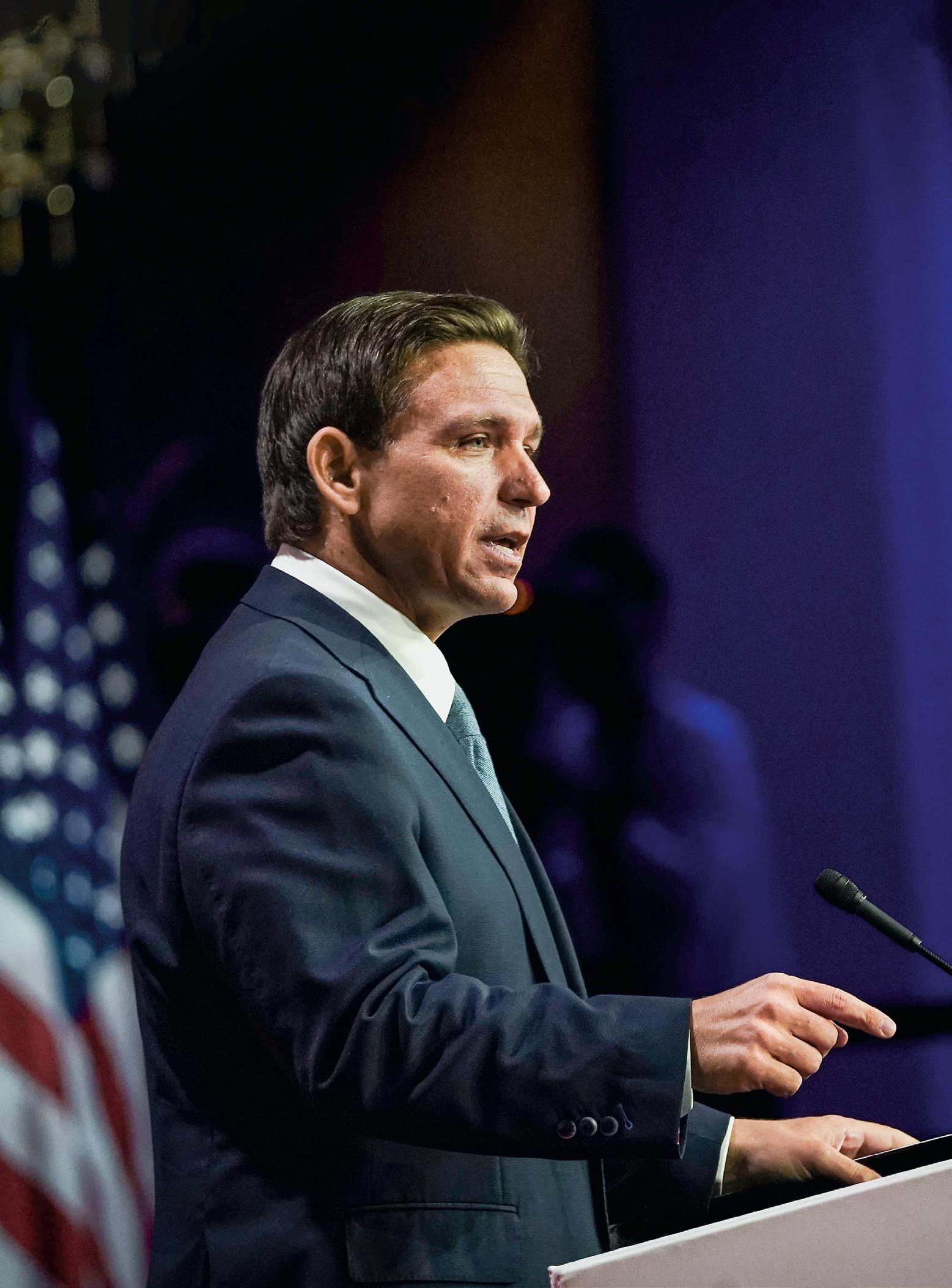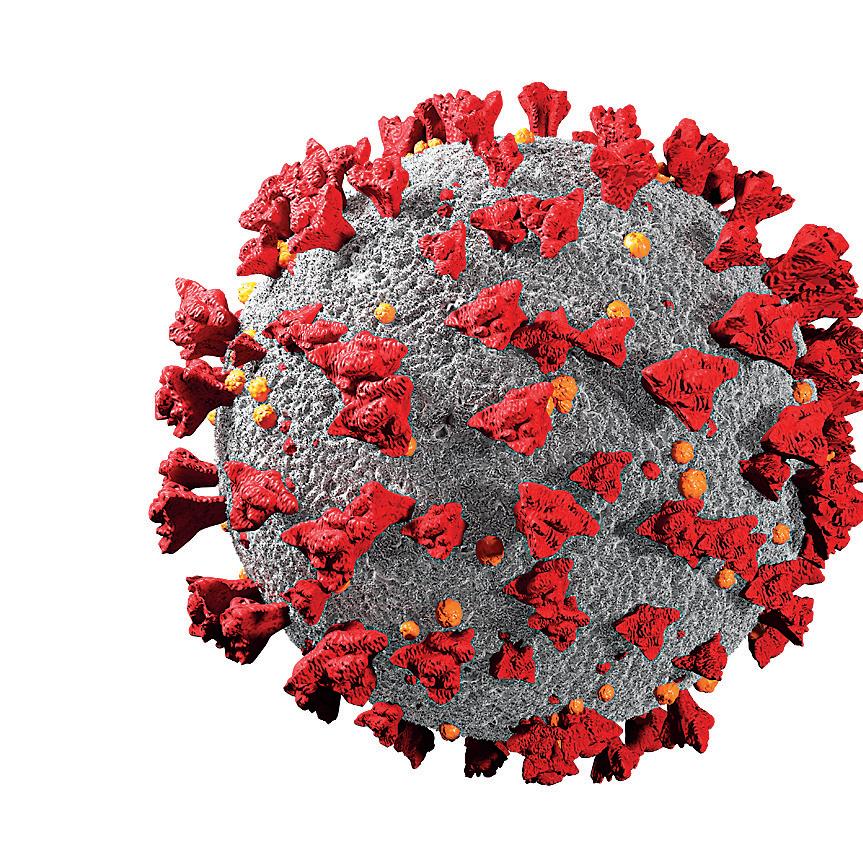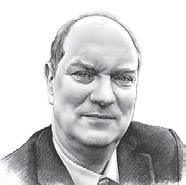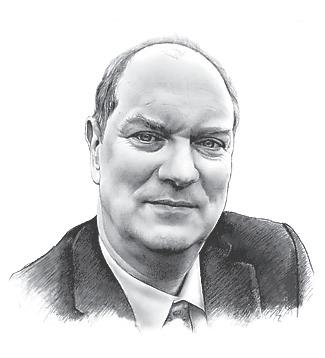REVEALING A SINISTER AGENDA
 By Darlene McCormick Sanchez
By Darlene McCormick Sanchez


 By Darlene McCormick Sanchez
By Darlene McCormick Sanchez

in the united states, while gender ideology and transgenderism have grabbed the most attention, conservatives and liberals alike have been sounding the alarm about queer theory, which has largely flown under the radar.
The Q that has been added to the LGBT acronym represents “queer theory,” which proposes to disrupt social politics. It doesn’t believe in limits on sexual behavior, including taboos such as pedophilia, incest, and bestiality.
Some critics of queer theory believe it’s only a matter of time before pedophilia becomes acceptable in society.
Epoch Times reporter Darlene McCormick Sanchez delves into queer theory, who’s behind it, and how it’s creeping into the United States.
On a different note, I’d like to take this moment to thank you as we close out this magazine. This is our final edition of Epoch Insight, as we are pivoting to a new range of special content that we believe will serve you even better.

We deeply appreciate your loyalty and support, and we look forward to continuing this journey with you!
America has been overlooking the queer movement, rooted in a sinister theory that seeks to normalize pedophilia.
ILLUSTRATION BY THE EPOCH TIMES, SAMIRA BOUAOU/THE EPOCH TIMES
Jasper Fakkert Editor-in-chiefJASPER FAKKERT EDITOR-IN-CHIEF

CHANNALY PHILIPP LIFE & TRADITION, TRAVEL EDITOR
CHRISY TRUDEAU MIND & BODY EDITOR
CRYSTAL SHI HOME, FOOD EDITOR
SHARON KILARSKI ARTS & CULTURE EDITOR
BILL LINDSEY LUXURY EDITOR
FEI MENG, BIBA KAYEWICH ILLUSTRATORS
SHANSHAN HU PRODUCTION
CONTACT US
THE EPOCH TIMES ASSOCIATION INC. 229 W.28TH ST., FL.7 NEW YORK, NY 10001
SUBSCRIPTIONS
READEPOCHINSIGHT.COM
GENERAL INQUIRIES, LETTERS TO THE EDITOR

HELP.THEEPOCHTIMES.COM
ADVERTISING
ADVERTISENOW@EPOCHTIMES.COM
(USPS21-800) IS PUBLISHED WEEKLY BY THE EPOCH MEDIA GROUP, 9550 FLAIR DR. SUITE 411, EL MONTE, CA 91731-2922. PERIODICAL POSTAGE PAID AT EL MONTE, CA, AND ADDITIONAL MAILING OFFICES.
POSTMASTER: SEND ADDRESS CHANGES TO THE EPOCH TIMES, 229 W. 28TH STREET, FLOOR 5, NEW YORK, NY 10001.
24 | Pet Cloning
Despite high costs, biotech firms say that price is often no object for grieving clients.
38 | DeSantis Campaign
A presidential candidate eyes a win in Utah, where conservatives are wary of Trump.
48 | Prescribing Veggies
Prescriptions for a better diet could slash health care costs.
52 | Type 1 Diabetes
A look at young people, COVID-19, and how to treat Type 1 diabetes.
56 | Big Government
“People over systems” is the new cry for freedom.
57 | CCP Propaganda
TikTok’s ambitious move into subsidized e-commerce sparks concerns.
58 | Jobs Market
U.S. companies are facing looming layoffs amid shrinking profits.
59 | Cancel Culture
The UK has stopped banks from canceling customers for their political views.
60 | Inflation
The idea of seller inflation is a myth created by statism.
THE LEAD 14 | Behind the Q
A look into the sinister theory behind the Q that was added to LGBT.
20 | 2nd Amendment
An ATF policy has forced nearly 2,000 gun vendors to close, a lawsuit says.
32 | Lockdown Cost
Business owners in Minnesota are still paying the price.
42 | ESG Funds
Investors are cool on “sustainable” investing after disappointing returns.
Former
61 | Home Insurance
There’s a lot to blame, including inflation, for the Florida insurance crisis.

62 | ‘Sound of Freedom’
Tim Ballard and Jim Caviezel discuss their new film on child sex trafficking.
68 | No Buts About It
It’s vital to learn to stop allowing selfdoubt to stifle success.
70 | An Amazing Estate
Built by Rod Stewart, this very private estate exudes luxury.
72 | Exploring Fabulous Tonga
While not easy to reach, this paradise is well worth the effort.
75 | The Taste of Scandinavia
American bottlers are now joining in on the popularity of Aquavit.
76 | Don’t Be a Target
Staying off the bad guys’ radar can help to avoid becoming a victim.
79 | 3-Wheeled Fun
These motorcycles prove that three wheels are better than two.
83 | Bring Your Furry Friend
Some tips on how to enjoy travel more by taking your pet along.

 MOUNT MERAPI, OR “MOUNTAIN OF FIRE,” spews lava during an eruption as seen from Sleman, Indonesia, on July 28.
PHOTO BY DEVI RAHMAN/AFP VIA GETTY IMAGES
MOUNT MERAPI, OR “MOUNTAIN OF FIRE,” spews lava during an eruption as seen from Sleman, Indonesia, on July 28.
PHOTO BY DEVI RAHMAN/AFP VIA GETTY IMAGES


Despite high cost and controversy, growing access to the procedure allows pet owners to heal emotionally. 24
Small-business owners are still feeling the residual effects of COVID-19 lockdowns. 32
Research has shown effective results by prescribing vegetables for medical diseases. 48
13%
U.S. first-time home buyers need to earn $64,500 per year to afford a “starter” home, a 13 percent increase from 2022, according to Redfin.
51%

A net total of roughly 51 percent of banks said they had tightened lending standards for commercial and industrial loans to larger and mediumsized businesses during the second quarter, according to the Federal Reserve.

9.58 MILLION
U.S. job openings fell to 9.58 million in June, the lowest level since April 2021, the Labor Department’s latest survey shows.
60%
About 60 percent of U.S. adults who responded to a survey expressed either a “great deal” or “quite a lot” of confidence in the U.S. military, according to a Gallup poll. That’s the lowest level of confidence in the U.S. military since 1997.
11 PEOPLE A federal jury in Pittsburgh has recommended the death penalty for Robert Bowers, the gunman who killed 11 people at a Pittsburgh synagogue. The federal death penalty is the first imposed during the presidency of Joe Biden, who had pledged during his 2020 campaign to end capital punishment.
“We need to maintain the safety of our citizenry.”
“TikTokNebraska Gov. Jim Pillen, on why he’s deploying more Nebraska Army National Guard soldiers to the U.S.-Mexico border
fitch ratings has lowered its Long-Term Foreign-Currency Issuer Default Rating for the United States to AA+ from its highest AAA rating.
The U.S. debt rating was lowered because of “the expected fiscal deterioration over the next three years, a high and growing general government debt burden, and the erosion of governance” over the past two decades, according to the credit-rating company.

the department of e ducation has started the process of enrolling student loan borrowers into its Saving on a Valuable Education (SAVE) plan, just weeks after the U.S. Supreme Court quashed the Biden administration’s attempt to forgive billions of dollars in student loans. SAVE is an incomedriven repayment (IDR) plan.
“A beta version of the updated IDR application is now available and includes the option to enroll in the new SAVE Plan—the most affordable repayment plan yet,” the Student Aid website states. “We’re accepting applications now to help us refine our processes ahead of the official launch. If you submit an IDR application now, it will be processed and will not need to be resubmitted.”
fifty-four elected officials in New York City have sent a letter to President Joe Biden to address the influx of illegal immigrants in the city, asking him to declare a federal state of emergency so the illegal immigrants can legally work in the country.

“We are elected officials from New York City requesting your help. Our City is experiencing an unprecedented migrant influx, with a surge of asylum seekers arriving here in numbers never seen before in history. Our City is at a breaking point,” wrote New York state Assemblywoman Jenifer Rajkumar.
Since early 2022, buses of illegal immigrants, sent from the southern border in Texas, have arrived regularly in the city.
in 2007, colorado ranked 34th in the nation for education, according to a report from CNBC. And within the state, Denver Public Schools (DPS) was in the bottom 10 districts for English language arts and math. At the time, DPS was Colorado’s second-largest district; it has since become the largest.
In its 2006–2007 class, DPS had a 39 percent high school graduation rate, a dropout rate of more than 10 percent, and just 1,324 students—out of 73,873—matriculated at a college.
The school system’s 2021–2022 class had a 76.5 percent graduation rate and a dropout rate of 3.8 percent. Now, Colorado comes in at 21st place nationally for education, according to CNBC’s 2023 report.
The striking improvement came about after DPS committed to a systemwide overhaul in 2008, according to a recent report by the University of Colorado’s Center for Education Policy Analysis.
The strategy involved embracing school choice, conducting an annual evaluation of each school’s performance, closing low-performing schools, and creating new schools.
climate change activists consistently warning of a doomsday in the near future are harming efforts to tackle the current situation, says professor Jim Skea, the newly elected head of the U.N.’s Intergovernmental Panel on Climate Change (IPCC).

“If you constantly communicate the message that we are all doomed to extinction, then that paralyzes people and prevents them from taking the necessary steps to get a grip on climate change,” he told German news agency DPA.
Mr. Skea, who has more than 40 years of experience in climate science, stressed that global temperatures increasing by more than 1.5 degrees Celsius compared with the pre-industrial era doesn’t pose an “existential threat to humanity.”
Mr. Skea told Der Spiegel magazine that “we should not despair and fall into a state of shock” if global temperatures increase by that amount and that “the world won’t end if it warms by more than 1.5 degrees.”
prime minister justin t rudeau and his wife, Sophie Grégoire Trudeau, have announced they are separating after being married for 18 years.

The former couple made the announcement in Instagram posts on Aug. 2.
Mr. Trudeau and Ms. Grégoire have three children between 9 and 15 years old. The Globe and Mail reports that the two are expected to have joint custody of the children, with Mr. Trudeau continuing to reside at Rideau Cottage, while Ms. Grégoire has moved to a separate home in Ottawa.
nearly half of parents have reported increased “socio-emotional difficulties” among their children after lockdown, according to a new study by the Institute for Fiscal Studies.
By February 2021, 47 percent of parents reported that their child’s social and emotional skills had worsened, while just 1 in 6 reported any noticeable improvement.
Examining the breakdown of age groups, 52 percent of children in the 4-to-7-year-old bracket were reported to have deteriorated in their socio-emotional skills. In the 12-to15 age bracket, the number was 42 percent. Fundamentally, the report highlighted better outcomes in the socio-emotional skills of “children whose parents had stable labour market experiences throughout the pandemic,” compared to “the skills of children whose families faced more economic instability.”
CHINA
china is implementing its recently announced export controls on two strategic metals, a move largely interpreted as retaliation for Western restrictions on the communist regime’s access to advanced semiconductors.
It’s estimated that China produces 60 percent of the world’s germanium and about 90 percent of the world’s gallium.

It’s not climate change. It’s not raging inflation or even the national debt. The real threat to the United States and to the world is the Chinese Communist Party’s (CCP’s) 100-year plan to defeat America and establish world domination. There’s no urgency in the mainstream media. That’s why “The Final War” had to be made. Anchored by senior investigative reporter Joshua Philipp, and one-and-a-half years in the making, “The
Final War” is a film that is so relevant to current events and so important that we’re offering it to EVERYONE for free. It will answer your questions about the pandemic, the impending invasion of Taiwan, and how the CCP works to keep the United States occupied with at least four global adversaries.
See the film. Know the danger. Be prepared. The final war is already underway.

‘THE
1. A member from a joint task force extinguishes a fire at a peat land in Pekanbaru, Indonesia, on July 31.

2. Protestors resist Turkish police during clashes over the deforestation project of a pine forest in Ikizkoy on July 29.

3. The coat of arms of the former Soviet Union is dismantled from the Motherland Monument in Kyiv, Ukraine, on Aug. 1.

4. A man walks along a trail after a monsoon storm passes by, in Tucson, Ariz., on July 28.

5. The waxing gibbous moon rises behind trees on a hill in Jindayris, Syria, on July 31, a day ahead of the “sturgeon supermoon.”

6. French athletes compete in the men’s 3,000-meter steeple final competition at the 2023 French Athletics Championships in Albi, France, on July 29.

The dark truth behind queer theory:

 By Darlene McCormick Sanchez
By Darlene McCormick Sanchez
Conservatives have zeroed in on the T in LGBTQ as part of the ongoing culture war.
But many may not realize the Q from the acronym stands for an even more extreme theory that defends pedophilia, incest, and bestiality, and advocates for a complete destruction of traditional sexual norms.
Q, which stands for queer, is rooted in queer theory, a sexuality ideology tied to socialism that began gaining popularity in the 1970s. Many philosophical founders and perpetrators of the theory have argued in favor of normalizing pedophilia and worse.
The recent surge in conservative focus on transgender ideology has left the queer movement to fester. National organizations such as the National Education Association and global organizations such as the World Health Organization advocate for sex education for children as young as kindergarten age.

At the same time, queer theorists embrace the idea that sexual consent laws should be eradicated for all children, even infants.
In the United States, although gender ideology and transgenderism have grabbed the most attention, conservatives and liberals alike have been sounding the alarm about queer theory, which has flown under the radar.
Commentator James Lindsay, author of “The Marxification of Education,” told The Epoch Times that queer theory has hijacked the gay rights movement.

In reality, the theory proposes to disrupt social politics. It doesn’t believe in limits on sexual behavior, including taboos such as pedophilia, incest, and bestiality.
Mr. Lindsay considers Michel Foucault, a French postmodern philosopher who wrote “The History of Sexuality” in 1978, the father of queer theory.
Foucault, accused of having sex with prepubescent boys as young as 8 in a graveyard in Tunisia, rejected all sexual labels and boundaries.
“It’s considered abnormal for an adult to want to have sex with a child,” Mr. Lindsay said. But pedophiles consider sex with children as normal. So for queer theorists, where anything goes, pedophilia is acceptable, he said.
Derrick Jensen is a lecturer and author of more than 20 books, mainly on environmental issues. At one point, the California resident would’ve considered himself an old-school environmental activist.
But, now, the left hates him because he dared to speak against queer theory.
“The left left us, and it’s like I am politically homeless,” he told The Epoch Times.
Mr. Jensen said queer theory is influenced by postmodernism, which doesn’t believe in truth or reality.
Similarly, queer theory examines what is normal and who that hurts or helps. He said the answer is simple: Normal is oppressive.
“Anything that is sexual must be acceptable,” he said, adding that means any type of fetish, or even rape.
Queer theory argues that the violation of the child doesn’t cause the harm done by adult–child sex—it’s caused by a society that makes the child feel guilty for having sex, Mr. Jensen says.
Like others, Mr. Jensen agreed that Foucault, who died in 1984, embraced pedophilia.
Foucault had sex with boys and “argued for the elimination of age of consent laws as in down to infants,” Mr. Jensen said.
Queer theory contributors such as Foucault and Gayle Rubin, another founder known for developing sex and gender political theories,
“It’s considered abnormal for an adult to want to have sex with a child.”
James Lindsay, commentator and author
contributed to an ideology that would rationalize “fetishes,” he said.
Allen Ginsberg, a well-known poet who died in 1997, embodied some of the movement’s ideas before queer theory came into being, Mr. Jensen said.
Ginsberg was a supporter and member of the North American Man/Boy Love Association and wrote a 1994 essay defending child sex.
“Pubescent boys and girls don’t have to be protected from big, hairy you and me. They’ll get used to our lovemaking (sic) in two days, provided the controlling adults will stop making these hysterical noises that make everything sexy sound like rape,” Ginsberg wrote.
Some critics of queer theory believe it’s only a matter of time before pedophilia becomes acceptable.
They point to incidents such as at the annual Drag March in New York, where participants chanted: “We’re here! We’re queer! We’re coming for your children!”
The Paris fashion house Balenciaga faced backlash recently after running an ad campaign
depicting little girls holding teddy bears wearing bondage gear. One ad showed pages from a child pornography court ruling. Balenciaga later apologized for the advertisement, but it demonstrated a growing trend.
Proponents of queer theory see it as a political tool to fight a patriarchal, oppressive system that has marginalized people with different sexual preferences than heterosexuals.
In a 2019 Marxist.com article by Yola Kipcak, the element of struggle against the system in queer theory was seen as positive but leaned too much into identity politics to spark a genuine socialist revolution.

The article lamented that capitalists could “present themselves as LGBT-friendly and paint a liberal and progressive image of themselves. Corporations such as Apple or Coca-Cola, which exploit tens of thousands of people in terrible working conditions, support LGBT campaigns in their companies or finance party trucks handing out free alcohol at commercialized Pride parades,” Ms. Kipcak wrote.
Jaimee Michell, the founder of Gays Against Groomers, a group that’s fighting against the use of gay culture to sexualize children, told The Epoch Times that queer theory is part of the gender ideology that has made its way into schools, where students use pronouns to “socially transition” while keeping it secret from parents.
Ms. Michell is convinced that it’s all leading in one direction.
Allowing minors to make decisions on transgender surgery is one step closer to allowing children to consent to sex with adults, Ms. Michell says.
“I believe the goal has always been to break down those barriers and to normalize pedophilia,” she said. “Some of the earliest proponents of queer theory and gender ideology were pedophiles.”
Allowing minors to make decisions on transgender surgery that would alter their lives forever is one step closer to allowing children to consent to sex with adults, Ms. Michell said.
“I think the push for queer theory in the classroom and gender ideology, indoctrinating them with pronouns, different genders that don’t exist in reality, is to push them toward and normalize them being able to consent,” she said.
In academic circles, the push is intensifying to classify pedophilia as another sexual orientation, instead of a mental disorder.
The term “minor-attracted person” grabbed headlines after transgender professor Allyn Walker used it during a discussion on pedophiles in November 2021.
Ms. Walker, a woman who transitioned to
Queer theory argues that the harm from violation of a child is caused by a society that makes the child feel guilty for having sex, Mr. Jensen says.
live as a man, was discussing her book: “A Long Dark Shadow: Minor-Attracted People and Their Pursuit of Dignity.”
In an interview with the Prostasia Foundation, Ms. Walker said it’s less stigmatizing to use the term minor-attracted person than the term pedophile when referring to people “who don’t act on their urges to have sex with children.”
And in May, transgender Minnesota lawmaker Leigh Fink, a Democrat, was successful in getting a key sentence removed from a state law—a change that critics say paved the way for pedophilia to become a sexual orientation.
The sentence that was struck from Minnesota’s Human Rights Act stated that “sexual orientation does not include a physical or sexual attachment to children by an adult.”
Elisabeth Taylor is an Australian professor with a doctorate in medieval history from Cambridge who served as the director of research for the Australian Christian lobby. She has been studying and writing about queer theory since 2016.
Like others, Ms. Taylor told The Epoch Times that queer theory aims to destroy norms.

She sounded the alarm in Australia when queer theory showed up under the “Safe Schools” program, much like gender ideology had infiltrated American schools.
Ms. Taylor said that children are taught that sexuality is malleable and fluid under queer theory and gender ideology.
She said that according to queer theory, heterosexuals oppress their own sexuality. But since they are in power, they are the oppressors of those who are sexually diverse.
Exchanging ‘Truth for a Lie’
Queer theory, in part, came out of the feminist movement, Ms. Taylor said. The links between the two can be traced to Ms. Rubin, who wrote the 1984 essay “Thinking Sex,” she said.
In the essay, Ms. Rubin discusses how sex with minors is stigmatized.
“Like communists and homosexuals in the 1950s, boylovers are so stigmatized that it is difficult to find defenders for their civil liberties, let alone for their erotic orientation,” she wrote.
Ms. Rubin described a hierarchical system of sexual value that placed married reproductive heterosexual couples at the top, followed by unmarried monogamous heterosexuals, with stable, long-term gay and lesbian couples coming next. At the very bottom are transsexuals, sadomasochists, and pedophiles, Ms. Taylor said.

“You might wonder how anyone could ever advocate pedophilia as a positive social good,” Ms. Taylor said. “All you need to do is exchange the truth for a lie in strategic places.”
Queer theory gives cover to pedophiles, she said, adding that its beginnings can be traced back to the 1940s.
She points to Alfred Kinsey, an American sexologist and biologist who founded the Institute for Sex Research at Indiana University in 1947. It now goes by the Kinsey Institute for Research in Sex, Gender, and Reproduction.
Kinsey, who died in 1956, viewed sex as a bodily function that responds to stimulus, much like the stomach responds to food during a meal, Ms. Taylor said.
Any social or psychological meaning attached to sex is, in Kinsey’s view, the product of culture, which is what scholars today call “socially constructed,” she said.
“Kinsey reasoned that if we don’t lock people up in prison because they have exotic tastes in food, then why should we lock people up in prison because they have unconventional sexual preferences?” Ms. Taylor said.
In Kinsey’s view, children are sexual beings from birth who are capable of sexual response, she said.
The official story of his study included input from pedophiles who assured him that children could have pleasurable sexual experiences, Ms. Taylor said.
In his 1948 book “Sexual Behavior in the Human Male,” Kinsey described “adult observers for 196 pre-adolescent boys” during sex.
The children, with ages listed as young as 5 on his chart, were “groaning, sobbing or more violent cries, sometimes with an abundance of
“The goal has always been to break down those barriers and to normalize pedophilia.”
Jaimee Michell, founder, Gays Against Groomers
tears (especially among younger children),” according to the book.
Another passage said that the boys would “fight away from the partner.” However, they “derived definite pleasure from the situation.”
The theory blames society for stigmatizing sex in any capacity—children wouldn’t feel traumatized having sex with adults if society thought it was acceptable, according to queer theory, Ms. Taylor said.
Parents who want to protect their young children from sexual predators or sexual knowledge are considered “phobic,” she said.
“It creates the ideological justification for the complete collapse of moral boundaries that are necessary to protect the vulnerable from sexual predation that causes trauma,” Ms. Taylor said.
Judith Butler, a feminist author of “Gender Trouble,” published in 1990, and “Undoing Gender,” published in 2004, is considered the queen of queer theory today. Her books question the relationship among sexuality, gender, and sexual taboos.
Ms. Butler, a University of California–Berkeley professor, teaches that gender identity doesn’t depend on biological sex and can be fluid.
Ms. Taylor said, “If you can’t tell who is a man and who is a woman, then you can’t distinguish between homosexual and heterosexual relationships, and in the gender confusion that results, norms are blurred, and all sexuality is queered.”
Mr. Jensen said that Ms. Butler goes so far as to advocate for incest.
“Judith Butler, who is today’s most prominent queer theorist, argues we need to ‘rethink,’ in
her word, the prohibition on parent-child incest because that prohibition violates the child by denying the child the agency to have sex with the adult,” he said.
Mr. Jensen predicts this period in American history under queer theory will be considered “insane,” much like lobotomies performed in past decades are now viewed as barbaric.
Future generations will wonder why society celebrated children surgically removing healthy body parts, potentially ruining their sexuality and ability to have children, he said.
“I think it’s an absolute atrocity,” Mr. Jensen said, adding that the only way to defeat the ideology is to speak out and refuse to use language such as “gender-affirming care” or preferred pronouns.
“My career has been destroyed by standing up for women and standing up on this issue,” he said. “But what I do know is crucial is for some of us to keep telling the truth as much as we can.”
Queer theory advocates for anarchy, where rules and norms don’t exist, he said.
Queer theorists embrace the idea that sexual consent laws should be eradicated for all children, even infants.
In reality, queer theory is a far-left political theory tied to German philosopher Georg Hegel, who influenced Karl Marx, the co-author of “The Communist Manifesto,” Mr. Lindsay said.

It goes beyond sex to embrace any fringe idea, he said. In religion, queer theory embraces Satanism; with body image, it supports Fat Studies; or with disabilities, it advocates for Crip Theory, an abbreviation of the word “cripple,” meaning disability.
“You can see how this thing becomes a sort of all-consuming monster because there’s absolutely nowhere you can stop,” Mr. Lindsay said.
He said there are two goals to queer theory: dissolve everything down to where there’s no definition of normal, and empower abusers.
“If the queer theorists got their way, our society would be anything goes,” Mr. Lindsay said.
“Nobody gets to define anything as right or wrong except them, conveniently. So every single individual becomes, you know, a standard unto himself.”
Derrick Jensen, an environmentalist, has been cancelled for speaking out against queer theory.


Shifting focus from consumer bans, Biden admin now targeting sellers, critics say
By Kevin StocklinHaving failed to pass gun bans to curtail Americans’ purchases of firearms, the Biden administration appears now to be attempting to restrict the supply of guns with a new “zero tolerance” policy at the Bureau of Alcohol, Tobacco, Firearms, and Explosives (ATF) that has put nearly 2,000 gun sellers out of business in the past two years, according to one lawsuit.
Starting in 2021, the ATF implemented an aggressive agenda in its inspections of Federal Firearms Licensees (FFLs), in many cases permanently revoking licenses over what defendants say are minor clerical errors.

“This is an end-around gun ban, because you start putting gun dealers out of business, and now, all of a sudden, it’s very difficult for people to purchase firearms,” Erich Pratt, senior vice president of Gun Owners of America (GOA), told The Epoch Times.
GOA filed a lawsuit on July 11 against the Biden administration in response to the ATF’s zero-tolerance enforcement.
The GOA lawsuit is requesting that the courts issue an injunction to end the ATF’s zero-tolerance policies and “declare that the [ATF] has acted unconstitutionally, arbitrarily, capriciously, and contrary to law, in the establishment of and/or application of standards for revocation of federal firearm licenses.”
According to the ATF, the agency revoked 88 FFL licenses in 2022, compared with five that were revoked in 2021.
But a recent GOA court filing reads: “In addition to revocations, ATF has coerced and intimidated an ever increasing number of FFLs into ‘voluntarily’ ceasing operations. In fact, the number of FFLs who discontinued business following a compliance inspection increased from 96 in 2020 to 789 in 2021 (the year that ‘zero tolerance’ was adopted) to 1,037 in 2022, an overall increase of more than 1,000%.”
The numbers the GOA cited correspond to investigations categorized by the ATF as “resolved as discontinued.”
“There is a clear animus in the written policies that the ATF pushes down on its employees that indicate this idea of, ‘We’re now going to attack the Second Amendment’ supply chain, since
we’re unable to convince Congress to pass ‘assault weapons’ bans, high magazine bans, or just bans in general,” John Harris, an attorney representing FFLs in their appeals of ATF licensing actions, told The Epoch Times.
According to The Trace, the self-described “newsroom dedicated to covering gun violence,” “[ATF] investigators conducted just over 7,000 inspections in 2022, compared to more than 13,000 in 2019,” before the COVID-19 pandemic curtailed investigations.
Even with half the number of prepandemic investigations, however, “they revoked more licenses in the past fiscal year than in any year since 2008,” The Trace reported.
David Chipman, a Biden nominee for heading the ATF who withdrew when his nomination failed to pass the Senate, told The Trace: “The trendline is good. I think we have to applaud the agency for holding the industry accountable.”
The Gun Control Act of 1968 (GCA) provides the basis for federal gun control, including regulations on interstate trade, firearm serial number marking requirements, establishment of “prohibited persons” who are prohibited from buying guns, and licens-
ing and record-keeping requirements for FFLs. The ATF is charged with enforcing this law.
One area of paperwork that often gets FFLs into trouble is Form 4473, which provides information on the purchaser and the weapon for the required background checks.
The GOA complaint reads, “Although these firearms transfer records originally included fewer than 30 information items ... the DOJ has, by regulation, incrementally and massively increased the data required on modern firearms transaction records to over 100 distinct data points, although Congress has never enacted any requirement that FFLs gather or maintain this information.
The GCA authorizes the ATF to revoke FFL licenses if record-keeping errors are “willful.”
LICENSES
THE ATF revoked 88 FFL licenses in 2022, compared to five that were revoked in 2021.
1,000%
THE NUMBER of FFLs who discontinued business following a compliance inspection increased by more than 1,000 percent from 2020 to 2022.
“Good-faith, clerical, and ultimately harmless errors in FFL record-keeping are a statistical inevitability. For example, ATF’s published data concerning its compliance inspections in 2020 reflects that it conducted 5,823 and found and reported errors in 43.7 percent of those inspections.”
The ATF’s website reads: “The GCA does not define ‘willful.’ The federal courts, however, have held that a willful violation of the GCA’s regulations occurs when the FFL commits the violation with an intentional disregard of a known legal duty or with plain indifference to their legal obligations. ... The courts have also held that a single willful violation of a GCA regulation is a sufficient basis for ATF to revoke an FFL’s license.”
In cases he has defended, the ATF is considering even small errors in filling out Form 4473 to be “willfulness,” according to Mr. Harris.
“When you’re writing down a serial number, you may transpose two digits, or you may leave one out, or a 6 may look like a G,” he said. “There are all kinds of errors that can happen that are completely innocent and have nothing to do with willfulness, but the ATF has developed this theory, and courts have allowed it, that says repeated errors are evidence of willfulness and therefore they’re a basis for revocations.”
Mr. Pratt said, “The ATF comes in and they say, ‘We gave you a manual years ago that you should have read, so any mistakes you make, no matter how minimal or clerical, they are willful violations. It’s such an unrealistic standard; if it was applied to the ATF, they would be put out of business because they’ve been shown to make these errors too.”
One former FFL owner, quoted anonymously, said the tone between gun shops and ATF inspectors has changed dramatically in recent years. In the past, he said, the ATF worked with FFLs that were having problems to get them back into compliance rather than shutting them down.
Even with half the number of pre-pandemic investigations, however, “[the ATF] revoked more licenses in the past fiscal year than in any year since 2008,” The Trace reported.
“We went from having a great relationship with our inspectors at the ATF

to really just being in constant fear of what we see as a political retaliatory move against our business and our industry,” he said.
According to the ATF, “Each of the following qualifying violations which impact public safety will result in ATF issuing a notice of revocation, absent extraordinary circumstances: Refusal to allow an ATF inspection; transferring a firearm to a prohibited person; failing to conduct a required background check; falsifying records; or failing to respond to a trace request.”
Much of the process of deciding whether to revoke licenses has been taken away from the inspectors, who would be able to make a judgment call about whether violations were intentional, according to Stephen Stamboulieh, an attorney at GOA. The ATF uses a computer system called Spartan, he said, into which ATF inspectors input data on violations, and an algorithm decides the FFL’s fate.
Very few of the violations are intentional, Mr. Stamboulieh told The Epoch Times, “because they don’t want to go to jail, and they don’t want to lose their license, their livelihood, and their ability to put food on the table for their family.”
“I don’t know what else to say about zero tolerance, except it’s wrong and it’s especially wrong in situations like this, and it leads to stupid results,” he said.
“They’re not putting the Palmetto State Arms out of business; here locally, they’re not putting the Shark Coast Tacticals out of business for noncompliance,” a Florida gun dealer who asked to remain anonymous told The Epoch Times, referring to larger firearms dealers. “They’re putting the small guys out that don’t have the resources to fight.”

“And the ATF is revoking licenses left and right, all across the United States.”
Critics of the Biden administration’s zero-tolerance policy also charge that it’s being applied unevenly, targeting smaller family-owned shops that don’t have the money to defend themselves in court.
The GOA argued in its lawsuit that “the Second Amendment does not permit the wholesale elimination of commerce in arms, or its concentration in a few large and anti-gun multinational corporations (such as Walmart) that refuse to sell most guns aside from a few shotguns and bolt-action rifles.”
“[The ATF] revoked more licenses in the past fiscal year than in any year since 2008.”
The Trace
 Jack (left) relaxes with identical kitty clones OJ and Thud.
Jack (left) relaxes with identical kitty clones OJ and Thud.
 By Allan Stein
By Allan Stein
Despite high costs, skepticism, biotech firms say price is often no object for grieving clients
HE WAS HER ROCK and emotional lifeline when her parents and brother died six years apart—beside her in times of trouble when life was too much to carry alone.

“When you get ‘the one’—some people never do—they just don’t understand it,” said Tammy, a retired health care worker in Scottsdale, Arizona.
“Jack was one in a jillion. He was just a perfect gentleman. Neat as a pin.”
Jack lived to be 18—a long life, by cat standards—succumbing to cancer in February and dying in Tammy’s arms at home.
But before Jack’s cancer diagnosis, Tammy had already decided to “clone” her beloved cat, despite the high cost and uncertainty of the procedure.
“A lot of people do cloning for themselves,” Tammy said. “I know this sounds silly—I did it for Jack,” whom she had neutered when he was young.
“He deserved sons.”
The cloning procedure took place two years ago for $25,000 and produced two nearly identical male kittens, each the spitting likeness of Jack.
Both kittens were born to their surrogate mother on Feb. 14, 2021—Valentine’s Day; both have extra toes on each paw and the same distinctive coloration that Jack had.
And both love to swim, travel, and carry socks in their mouth, just like Jack.
Tammy named her two cloned kittens OJ and Thud; they owe their existence to advancements in cloning technology over the past three decades.
Tammy said she knew that the procedure wasn’t only expensive, it was also controversial.
She’s received many messages on Facebook that condemn her decision to clone Jack as “Satanic,” “unnatural,” and unwise for her to play God.
And these people were “ungodly rude” about it, Tammy said. For this reason, she asked that her last name not be used in this story.
However, she said that most people on social media tell her they’re curious about cloning and think it’s “amazing.”
Pet cloning involves making a genetic
copy of a living or deceased pet, usually a dog or cat, by extracting DNA from the host animal to produce live embryos for placement inside a surrogate mother, where they develop until they’re born.
According to market analyst Dataintelo, pet cloning is a global market that’s projected to grow by 9.1 percent annually between 2022 and 2030.
“The market can be attributed to the increasing demand for pet cloning services, rising awareness about the benefits of pet cloning, and technological advancements in the field of pet cloning,” the company website states.
There are two types of pet cloning: the cloning of deceased animals and the cloning of live animals. Both use similar techniques.
Since the controversial birth of Dolly—the first cloned sheep—in 1996, several companies have emerged to reap the lucrative commercial rewards of pet cloning.
BioVenic and Gemini Genetics in the United States and Sinogene in China are among them. Pet cloning is also big business in South Korea, where some
SCOTTSDALE, Ariz.— “Jack” wasn’t just any house cat. He was Tammy’s best friend for almost two decades.
elite clinics fetch $100,000 for a cloned dog.
For the past 20 years, ViaGen Pets and Equine in Texas has cloned horses, livestock, dogs, and cats for hundreds of clients across the United States.
“I think most clients hope to recreate that special bond [with a deceased pet]—and I certainly understand that,” said ViaGen’s client service manager, Melain Rodriguez, who has had many cats and dogs in her lifetime.
“Although you love them all, you had a special relationship with that one special [pet] that stands out. It’s so hard when it’s gone.”
In 2016, ViaGen delivered the first cloned puppy in the United States: a Jack Russell terrier named Nubia, an identical twin of its genetic donor.
Ms. Rodriguez said ViaGen cloned horses and livestock primarily before branching out to clone pets and even threatened or endangered species.
The procedure is intricate and costly—$50,000 for a cloned dog at ViaGen—and carries the potential risk of failed embryos and unwanted heritable traits.
Several nationwide polls find that most Americans in sample groups oppose cloning on moral or religious grounds.
Opponents of animal cloning cite inherent health and safety risks, flaws
Jack, part Siamese, lived to be 18, which is a long life by cat standards, before succumbing to cancer. Jack loved swimming in the pool with his owner, Tammy, going on long car or motorcycle rides, and walking on a leash in public.

in the developing technology, and the lack of government oversight and regulation.
The American Society for the Prevention of Cruelty to Animals (ASPCA) has called for a moratorium on cloned and bioengineered pets.
During the moratorium, a multidisciplinary commission would evaluate existing cloning research and technology, including regulations regarding its use.
“Our current knowledge of animal cloning indicates that there are important welfare concerns at issue,” the ASPCA position statement reads. “Reports on the health and condition of mammalian animals produced by cloning have indicated a variety of anatomical and physiological problems.
“It is difficult to document fully the consequences of cloning or bioengineered applications of companion animals since many of these activities fall outside the framework of publicly funded and regulated research programs.”
The U.S. Conference of Catholic Bishops (USCCB) opposes cloning on moral grounds; it states on its website that more than 90 percent of cloned embryos are miscarried or stillborn.
“Dolly, the cloned sheep, was the sole survivor of 277 attempts. Those few who survive have serious medical problems,” a statement on the USCCB website reads.
Many scientists oppose reproductive cloning of humans for these reasons “but still favor cloning for research,” according to the statement.
The American Anti-Vivisection Society said that it opposes animal cloning as a potential threat to animal welfare.
The organization launched two campaigns to stop animal and pet cloning to “protect both animals and people from being exploited by companies attempting to ‘bring back a deceased companion animal.’”
Opposition to animal cloning is also widespread in the European Union. In surveys in 2008 and 2010, the European Consumer Organization found overwhelming opposition to cloning in European countries.
More than 80 percent of respondents had concerns over cloning’s long-term effects on nature. In 2008, 58 percent found cloning “totally unacceptable for food production,” and 67 percent responded that way in 2010, and 69 percent felt cloning would risk viewing animals as commodities.
Additionally, 83 percent said they would want food labeling on products derived from the offspring of cloned animals in European supermarkets.
The organization said that commercial livestock cloning, including that of beef and dairy cattle, occurs mainly in the United States, Canada, and Argentina, with “some activity” in New Zealand, Australia, and China.
“In short, only the United States and Argentina have done much cloning of food animals,” Jaydee Hanson, policy director for the U.S.-based Center for Food Safety, told The Epoch Times.
“Most other countries treat clones as a new animal requiring extensive review. Europe and Canada do that. Japan has limited approvals of clones for food and requires labeling, which prevents most markets from carrying meat from clones or their offspring,” he said.
Mr. Hanson said that the genetically engineered GalSafe pig is the only cloned and FDA-approved meat product sold in U.S. supermarkets. But you can’t just “go to the supermarket and tell you’re getting the offspring of a cloned animal,” he said.
“What you’re seeing in the food sector is a decline in the practice,” he said. “The animal clones are dogs, cats, and horses,” and a few other species.
The center believes that animal cloning is “generally not safe,” absent long-term FDA studies, Mr. Hanson said.
“We know there are animal welfare implications; large offspring syndrome is a huge problem with cloned animals. The fetuses are large, and it kills them,” he said.
Cloned kittens OJ and Thud just weeks after being born at a ViaGen Pets lab in the United States. Tammy says she knows OJ and Thud are only the likenesses of Jack as individuals. But they share many similar interests as Jack. Both kittens have extra toes on each paw and the same distinctive coloration that Jack had. They also love to swim, travel, and carry socks in their mouth, just like Jack.
“It also happens in traditional breeding. It just happens more often with cloned animals. The thing about pets is people have such a love for their animals. That’s understandable.”
As a relatively new commercial industry, pet cloning fills a growing niche market, but there “aren’t that many people that can pay $50,000 to have a Xerox copy of their cat or dog,” Mr. Hanson said.

Part Siamese, Jack had dazzling blue eyes, a thick brown-black coat as smooth as velvet, and an extra toe on each paw because of a congenital deformity called polydactylism.
Unlike most domestic short hairs, Jack loved the water—swimming in the pool with his owner, Tammy—going on long car or motorcycle rides, and walking on a leash in public.
Tammy said she desired to preserve these endearing traits in Jack through cloned offspring.
During a routine tooth cleaning at a veterinary clinic in 2015, Tammy had skin cells removed from Jack’s stomach and stored at ViaGen Pets.
In 2021, she decided to proceed with the cloning procedure.
About nine weeks later, she received
two genetically cloned kittens for the price of one.

“I burst into tears when I saw them on the little carrier,” Tammy told The Epoch Times. “When they turned to look at me, I lost it. They were identical. The big paws, the bright blue eyes—identical to Jack. Perfect.”
“There’s nothing I can say other than amazing.”
Ms. Rodriguez said that the media and Hollywood perpetuate the belief that cloning is dangerous and evil.
The 1992 movie “Jurassic Park” capitalized on the public’s fear of the unknown using a fictional island populated by cloned dinosaurs that were brought back from extinction. The dinosaurs ran amok through corporate sabotage, causing mayhem and destruction when the system broke down.
“A lot of the negative thoughts about cloning have come from Hollywood,” Ms. Rodriguez said. “They think that’s what it’s like. Most people who don’t fully understand the process are the ones who tend to be the most fearful of it.”
Animal cloning—whether it involves a horse, cattle, sheep, dog, cat, or fer-
ret—is different from normal sexual reproduction.
At ViaGen, the process begins with harvesting cells from a donor animal using a skin biopsy kit; the cells are then sent to ViaGen’s facilities for storage.
The cells remain in stasis in liquid nitrogen for weeks, months, years, and even decades, until the client is ready to clone the pet.
About 85 percent of ViaGen’s business consists of long-term storage clients, who store their pet’s donor cells at a yearly cost of $150, Ms. Rodriguez said.
The next step in cloning involves growing millions of cells in a lab environment.
Using a high-tech microscope and the “somatic cell nuclear transfer process,” the lab technician injects a single cell into a donor egg with the nucleus removed.
A jolt of electricity causes the cell to divide and grow as a living embryo.
Multiple eggs are inserted into the surrogate mother and allowed to gestate until at least one cloned kitten or puppy is born; sometimes, there’s more than one.
In most cases, the offspring are healthy and robust genetic copies of the original donor, Ms. Rodriguez told
The Epoch Times.
“We do see, for the most part, that cloned animals live a normal lifespan and are just as healthy as the original animal,” with a few caveats, she said.
Ms. Rodriguez said that it’s essential for clients to have reasonable expectations about pet cloning.
For example, a cloned pet isn’t the same as the host pet that died. Given the likelihood of slight genetic variations, there might be differences in coloring, behavior, and temperament.
If a host dog or cat died from an inherited illness, that illness may carry over to the cloned offspring.
“Anything that is genetically linked, as far as illness, the clone will have the same genetics and the same potential to develop that illness at some point in its life,” Ms. Rodriguez said.
Environment plays a significant role in how a cloned pet acts and reacts. And sometimes, it’s the pet owner who’s different.
ViaGen recently decided to bring the first clones of the endangered blackfooted ferret and Przewalski’s horse into the world.
9.1%
PET CLONING IS a global market projected to grow by 9.1 percent annually between 2022 and 2030, an analyst says.
$100,000
PET CLONING in South Korea can cost up to $100,000 for a cloned dog at some elite clinics.
90% THE U.S. Conference of Catholic Bishops opposes cloning on moral grounds, stating on its website that over 90 percent of cloned embryos miscarry or are stillborn.
While time often heals the emotional wound of losing a pet, people change with time, Ms. Rodriguez said.
They may feel and behave differently while interacting with a genetic copy of a beloved pet that died years ago, which may influence the pet’s personality.
Yet, she said, there’s no limit to how many times one can clone a pet to resurrect that priceless bond.
“It’s a very personal decision and not for everyone. It’s the next best thing to going to the breeder and getting another dog with the same parents.”
Ms. Rodriguez acknowledged critics who feel that cloning pets is “unnatural,” and even immoral, despite the process being similar to the in vitro fertilization procedure that has become common in family planning.
The technology shows even more promise in the “conservation cloning” of threatened or endangered species.
Using cloning tools and technology,
“Where I see cloning technology headed is helping support endangered species,” Ms. Rodriguez said.
Ms. Rodriguez said the main reason for cloning a pet is the desire to recreate the “family” bond that existed with a deceased dog or cat.
It’s one way to approach enduring the grief that comes with death. For many pet owners, the cost is often no object.
“I think it’s that special relationship—that special bond they had with their pet. We commonly hear that they had many dogs, but nothing like this dog, and they can’t imagine life without this dog.”

Before cloning became an option, Tammy said that Jack was her pride and delight, an abandoned stray cat “somebody threw out because he had extra toes.”
“He was utterly stunning in every way,” she said, and cloning seemed the best and only option to continue his
genetic legacy.
Jack spent two years bonding with his cloned “sons” before he passed.
“He smelled them face to face” when they first met in 2021, and “immediately started grooming them. He accepted them—loved them deeply,” Tammy said.
“They all slept together. They took care of each other. If people could be so good to each other.”
Tammy said she knows that OJ and Thud are only the likenesses of Jack as individuals.
“We are an amalgamation of our own experiences as individuals, so they’re not going to be precisely the same. But they share many weird things, like carrying socks around—Jack loved socks—kneading on things, singing to their ‘people,’ [and] peculiar things that Jack loved: cars, music. That was a big thing.”
When Jack died, Tammy refused to have him cremated and buried him in her backyard.
“I bought him a coffin and everything,” she said.
Tammy feels fortunate to have the choice of whether to clone Jack as often as she wants.
His cells will remain at ViaGen for years to come.
“He was family to me,” Tammy said. “I know he was a 17-pound little animal, but to me, he was my best friend. He was the coolest.”

BANGLADESH NATIONALIST PARTY (BNP) activists set a bus on fire as they block a highway during a protest amid anger over the cost of living, demanding Prime Minister Sheikh Hasina’s resignation, in Dhaka, Bangladesh, on July 29. The BNP has been calling for the election due in January 2024 to be held under a neutral caretaker government.
 PHOTO BY -/AFP VIA GETTY IMAGES
PHOTO BY -/AFP VIA GETTY IMAGES
A person walks by an empty restaurant in New York on May 18, 2020. Recent studies indicate the past three years of COVID lockdowns and mandates might have all been for nothing.

‘We hung on as long as we could,’ says former Minnesota business owner

St. C loud, Minn.—i n late 2019, Darin and Michelle Agnew were ready to open their dream business in St. Cloud, Minnesota.
The four-story building in historic St. Cloud was built in 1886. The Agnews had renovated the structure, installing a modern kitchen, plenty of dining space, and a bar featuring 76 beer taps.
“The second largest in the state,” Ms. Agnew said.
They had had some setbacks—equipment and construction issues during the renovation, and Ms. Agnew had been injured in an automobile crash— but those were behind them and the future looked bright.
Sure, they had accumulated some debt, which goes with opening a new business. But now, they were ready to get to work serving their customers. And they did, for one month.
Then the COVID-19 pandemic hit.
Gov. Tim Walz began issuing executive orders, bars and restaurants were closed, and the Agnews’ dream died.
“We hung on as long as we could,” Ms. Agnew said.
Minnesota Attorney General Keith Ellison, Mr. Walz, and the Minnesota Department of Health didn’t respond to The Epoch Times’ calls and emails seeking comment.
On March 16, 2020, three days after declaring a peacetime emergency, Mr. Walz issued an executive order closing most bars and restaurants in an effort to stop the spread of COVID-19. The order didn’t apply to “restaurants and food courts inside the secured zones of airports.” The order didn’t explain why they were exempt.
The order was presented as a temporary measure to “flatten the curve.” It was followed by increasingly strict policies for the next three years.
Like the Agnews, fellow business owners Lisa Monet Zarza and Lisa Hanson said the order was the beginning of the end for their businesses. While the order did allow some takeout and delivery, they said such service wasn’t practical for most bars and dine-in restaurants. An attorney who fought such pandemic policies in court agrees.
Misha Tseytlin, a partner with nation-
al law firm Troutman Pepper Hamilton Sanders LLP, represented businesses and individuals fighting such policies during the pandemic.
“What happened over that three-year period was a tragedy and, in my view, is contrary to what America is about,” he said.
After losing her Minnesota licenses for defying the lockdown orders in December 2020, Ms. Zarza opened the Outpost Bar and Grill in Bay City, Wisconsin.

The Outpost is like thousands of other local bars, including the Alibi Drinkery, Ms. Zarza’s old bar in Lakeland, Minnesota.
The television over the bar is often tuned to a sports channel on mute as classic rock plays over the bar’s sound system. It’s the kind of place where people might spend an early summer day enjoying beer, the Cajun blackened shrimp on the menu (which Ms. Zarza
recommends), and conversation.
Many of the regulars are small-business owners like Ms. Zarza, who started at the bottom of their vocational ladders and worked their way up.
“They’re blue-collar business owners,” Ms. Zarza told The Epoch Times.
She said that initially, she and her business partner wanted to do their part to fight the virus in Minnesota. But it quickly became clear that their business couldn’t survive under the lockdown policies.
She said state leaders turned a deaf ear to restaurant and bar owners’ pleas.
Ms. Hanson was one of those owners. She’s a friendly, outspoken businesswoman and grandmother with a strong sense of right and wrong.
In 2015, she and her husband bought a coffee shop in a 100-year-old building in downtown Albert Lea, Minnesota. When they opened The Interchange Wine and Coffee Bistro, they envisioned a cozy place for a glass of wine or cup of joe.
She said they got that and more.
They opened a kitchen that featured a breakfast and lunch menu. For $12, you could get a plate of “Vern’s Sensational Shrimp Scampi” or a gourmet flatbread that the menu touted as “better than pizza.”
They started hosting private parties and public events and featuring live music on Friday nights.
“It was kind of a happening place in downtown Albert Lea,” Ms. Hanson said. “It wasn’t a big business, but it kept me busy.”
Ms. Hanson decided she wasn’t going to take the forced closures lying down. She and Ms. Zarza were part of an online group called “Reopen Minnesota Coalition.” Members of the group took a public stance in opposition to the lockdown orders and vowed to open their busi-
nesses in protest.
Ms. Zarza said she thought that standing up for her rights and those of others was the right thing to do.
“I always thought that if you did the right thing, everything would be OK,” Ms. Zarza said.
Despite the initial setbacks, things were falling into place for the Agnews to finally open their restaurant, Searles on Fifth Avenue, in February 2020.

On Feb. 17, 2020, a neighboring business burned down. The fire taxed the capabilities of the St. Cloud fire and police departments, which were on the scene for hours. Even though Searles wasn’t open yet, Mr. Agnew went into the kitchen and cooked steaks for all the emergency personnel.
Darin Agnew, thenowner of Searles, cooks steaks for firefighters on Fifth Avenue in St. Cloud, Minn., in February 2020. As lockdown policy was issued, Michelle Agnew said many of the St. Cloud residents who had praised Searles on Fifth Avenue just weeks prior switched to accusing them of endangering their neighbors out of greed.

Searles’ social media accounts were flooded with praise from St. Cloud residents. When they opened the business a week later, Ms. Agnew felt they had turned a corner.

“We had both floors full and a line out the door,” she said.
With Saint Patrick’s Day coming, the Agnews stocked up with beer and food. Things were looking good. Then, on March 13, 2020, the governor issued Executive Order 20-01, declaring a peacetime emergency. After being open for only one month, Searles on Fifth Avenue was closed.
The Agnews lost their inventory and the ability to pay their bills. They also learned that they didn’t qualify for financial aid.
To determine how much aid they could receive, they had to subtract what they made to that point in 2020 from what they made in 2019.
But, they had only been open for one month in 2020 and closed all of 2019. They received some assistance from the Paycheck Protection Program to pay employees, but there was no help with other expenses.
“We basically lost about $1.4 million from the shutdown,” Mr. Agnew said.
They joined the Reopen Minnesota Coalition and defied the executive orders by reopening their business in December 2020, hoping to recoup some losses. But for them, it was too little, too late.

Ms. Hanson and Ms. Zarza also reopened their businesses in December 2020, and the state came down hard. They had expected more than 100 other businesses to open. but in the end, only about 15 did.
By November 2021, Ms. Hanson’s legal problems over the COVID-19 lockdown, combined with the mounting expenses, were becoming a burden. Then, the city, which owned the building in which The Interchange was located, refused to renew the lease.
The business closed in 2022, and eight people, besides Ms. Hanson, lost their jobs.
“It was too much,” Ms. Hanson said. “We had business, it was just too much.”
Both women now face hundreds of thousands of dollars in fines. Ms. Hanson was sentenced to 90 days in jail but was released after 60 days, having earned time off for good behavior.
They say that not a single case of COVID-19 was traced to their restaurants.
“The state has been nasty, nasty through all of this. We have not been quiet about it,” Ms. Hanson said.
On May 23, District Judge David Knutson ordered Ms. Zarza’s company, Lionheart, to pay more than $400,000 in fines, fees, and court costs.
The state also asked the court to find Ms. Zarza personally liable based on evidence that Ms. Zarza and her business partner used their company debit card to pay for travel, medical procedures, and other personal expenses.
Judge Knutson ruled that that would have to be done in a separate action.
Ms. Zarza’s attorney, Richard Dahl of Brainerd, Minnesota, expressed disbelief.
“So, you’re not allowed to take your own company’s money and pay your
bills? It’s ludicrous to me,” Mr. Dahl told The Epoch Times.
On June 7, 2022, after two years of struggling to keep the doors open, the Agnews threw in the towel.
They sold the building for less than its market value. Mr. Agnew has returned to work, and Ms. Agnew works as much as possible while recovering from her brain injury.
gry comments, including death threats.
Ms. Agnew said many of the St. Cloud residents who had praised Searles on Fifth Avenue just weeks prior switched to accusing the business owners of endangering their neighbors out of greed.
Ms. Hanson said the health inspector, who had always been friendly, had a distinctly different attitude as he attached a temporary restraining order to the front door of her business.

At the same time, big box retailers, casinos, airport restaurants, and other businesses continued operating. Ms. Zarza said the situation made no sense.
“It baffles me,” she said.
The authors of at least two studies say that the lockdowns failed to live up to their billing as life-saving measures.
“There was just no help anywhere,” Ms. Agnew said. “Right now, we’re just trying to dig out.”
Money was only one of the stress factors the business owners faced.
Ms. Zarza’s business was vandalized, and her social media was filled with an-
“Our results show that more severe government interventions ... did not significantly improve health outcomes ... relative to states that imposed less restrictive measures,” a February study on government pandemic policies stated.
Paragon Health Institute published the study, titled “Freedom Wins.”
Paragon describes itself as a nonprofit, nonpartisan research institute that evaluates government programs,
“WE BASICALLY LOST ABOUT $1.4 MILLION FROM THE SHUTDOWN.”
Darin Agnew, former small-business owner
develops policies, and works within the government to implement reforms. The report says the lockdown policies did impact communities.
“The severity of the government response was strongly correlated with worse economic (increased unemployment and decreased GDP) and educational (days of in-person schooling) outcomes,” the report reads.
Paragon was one of many entities to find fault with the lockdowns.
The Institute of Economic Affairs (IEA), based in the United Kingdom, published “Did Lockdowns Work? The Verdict on COVID Restrictions,” a 220page meta-analysis of 22 studies.
The authors—Jonas Herby, Lars Jonung, and Steven Hanke—reviewed more than 19,000 studies, winnowing them down to 22 that contained suitable data for meta-analysis. The authors found that contrary to what proponents of the strict policies say, lockdowns did little to preserve life.
According to the IEA report, lockdowns saved 1,700 lives from COVID-19 in England and Wales, 6,000 across Europe, and 4,000 in the United States. At the
same time, between 18,500 and 24,800 people die from the flu in England and Wales each year. Across Europe and the United States, the flu kills 38,000 and 72,000 people annually, respectively.
“These results pale in comparison to the Imperial College of London’s modeling exercises (March 2020), which predicted that lockdowns would save over 400,000 lives in the United Kingdom and over 2 million lives in the United States,” the IEA says.
Both reports claim that the data from countries that enforced strict lockdowns aren’t much different from those in more permissive areas. This is borne out in data from Minnesota and its neighbor, Wisconsin.
According to TrackTheRecovery.org, Minnesota and Wisconsin’s pandemic journey mirrored the rest of the nation, though they took different tacks.
Recent studies indicate that the past three years of COVID lockdowns and mandates might have all been for nothing.
“COVID-19 lockdowns were a ‘global policy failure of gigantic proportions,’” reads the study published by the IEA.
Buried in the data on the website TrackTheRecovery.org is evidence that state officials may have realized that their policies were inadequate and per-
haps even harmful.
Opportunity Insights, a nonpartisan nonprofit at Harvard University, hosts TrackTheRecovery.org, using data from The New York Times, the Centers for Disease Control and Prevention, the Johns Hopkins Coronavirus Resource Center, and the U.S. Department of Health and Human Services.
Mr. Walz issued Executive Order 2099 on Nov. 19, 2020, because Minnesota showed a spike of 120 new COVID-19 cases per 100,000.
The 23-page order declared that previous efforts to control the spread of the virus needed to be increased to deal with the increased rate of infection.
“The virus is everywhere, meaning that every interaction we have with people outside our households poses a risk of transmission,” the order reads.
The small-business owners who spoke to The Epoch Times cited Executive Order 20-99 as the most damaging to their businesses. Less than two years later, it appeared that Mr. Walz had grown less concerned about increasing COVID-19 cases.

On Jan. 25, 2022, Minnesota reported a precipitous increase of 294 new cases per 100,000 persons.
The Epoch Times could find no evidence that the state of Minnesota issued any directives in direct response to these numbers.
Mr. Tseytlin opined on why Minnesota officials adopted what he called “draconian measures.” He said few people were willing to stop them.
The attorney represented small businesses and the state Legislature in Wisconsin against Wisconsin Gov. Tony Evers’s attempt to impose lockdowns similar to those in Minnesota.
Mr. Tseytlin told The Epoch Times that lockdowns exposed a weakness in society that allows government officials to run roughshod over individual liberties and constitutional rights.
Mr. Tseytlin said he was “dismayed” that more lawyers didn’t take up the fight against the lockdown policies.
“All [lockdowns] did was kill businesses, and steal education from kids. It was very frustrating to me how many lawyers did not step up at a time when they should have.”
Republican presidential candidate and Florida Gov. Ron DeSantis speaks at the Faith and Freedom Coalition’s Road to Majority conference in Washington on June 23.
 PHOTO BY MADALINA VASILIU/THE EPOCH TIMES
BY THE EPOCH TIMES, NAMLLASUM/SHUTTERSTOCK
PHOTO BY MADALINA VASILIU/THE EPOCH TIMES
BY THE EPOCH TIMES, NAMLLASUM/SHUTTERSTOCK
Candidate eyes Super Tuesday victory in state where conservatives are wary of Trump
BY JOHN HAUGHEYThere’s little doubt that a Republican will garner Utah’s six electoral votes in the November 2024 presidential election, but who that nominee will be is another question, and the state’s GOP primary is one of 15 contests that will be staged nationwide on “Super Tuesday,” March 5, 2024.
Seven months before that clash, it doesn’t appear that Beehive State voters are buzzed about the prospect of seeing former President Donald Trump’s name on the ballot, a glimmer of opportunity that the dozen candidates struggling for traction in the GOP presidential race against the dominant front-runner will seek to exploit.
Florida Gov. Ron DeSantis’s two July 21 campaign appearances in the Salt Lake City area are evidence that GOP underdog candidates seeking to derail Mr. Trump’s 2024 Republican presidential drive see Utah as a weak link in his path to the nomination.
“The more people see Gov. DeSantis and hear his forward-thinking plan for our nation’s comeback, the more inspired they become to vote for him for president,” DeSantis’s campaign spokesman, Andrew Romeo, said in a statement announcing that the Florida governor would meet with state lawmakers and Utah’s Republican Gov. Spencer Cox in Salt Lake City before attending an evening fundraiser.
It’s Mr. DeSantis’s second Utah trip since April, when—even before formally declaring his candidacy in May—he was the keynote speaker at the state Republican Party’s convention, where
UTAH HASN’T HAD a Democratic governor for more than 40 years.
FOR MORE THAN 80 years, Utah voters have almost exclusively sent Republicans to Congress.
he called Florida the “Utah of the Southeast,” a line similar to one he delivered in Iowa (where he called his state the “Iowa of the Southeast”) and likely similar to others he’ll use elsewhere.
Reddest of the Red
Utah is among the reddest of red states. Republicans hold supermajorities in the state Legislature—23–9 in the Senate; 61–13 in the House— and a Democrat hasn’t been elected governor since 1980.
For more than 80 years, Utah voters have almost exclusively sent Republicans to Congress. A Utah Democrat hasn’t been elected to the U.S. Senate since Frank Moss won a second term in 1970. Democrats haven’t been competitive in three of the state’s four congressional districts for decades.
The most recent Utah Democrat to win a congressional race was former Rep. Ben McAdams in 2018. He served one term before being ousted by Rep. Burgess Owens.
Republican candidates have won every presidential election since Lyndon Johnson took the state in 1964, including two victories by Mr. Trump.
But Utah voters have what often appears to be an arm’s-length relationship with the former president, who finished third in Utah’s 2016 Republican presidential caucuses behind Texas Sen. Ted Cruz and Ohio Gov. John Kasich.
He went on to easily defeat Democrat Hillary Clinton by a 45.5 percent to 27.5 percent margin, but it marked only the second time since 1968 that a GOP presidential candidate garnered less than
50 percent of the overall tally.
That shortfall was fostered by conservative and former Republican Evan McMullin’s 2016 third-party run as an independent. He was registered in only a handful of states, but in his native Utah, Mr. McMullin earned 21.5 percent of the vote, the best third-party performance by a presidential candidate in any single state since Ross Perot did better in several states in 1992.
Mr. McMullin essentially made Mr. Trump his sole campaign issue, and in the 2022 midterms, Mr. McMullin again ran as an independent on the same anti-Trump platform and nearly upset Sen. Mike Lee (R-Utah)—endorsed by Mr. Trump—in a bitter midterm general election.

In 2020, without a primary challenge or a third-party presence in the election, Mr. Trump easily defeated Joe Biden, 58.1 percent to 37.7 percent. But that 37.7 percent tally collected by Mr. Biden was the largest percentage of the general election vote for a Democratic presidential nominee since 1964.

Mr. McMullin isn’t alone among Utah’s conservatives in his outspoken criticism of Mr. Trump. Prominent Beehive State Republicans—from the governor’s office to the state legislature to Congress—challenged the former president while he was in office and have continued to do so ever since.
Sen. Mitt Romney (R-Utah) is among the former president’s most vocal disparagers. Despite his “RINO” denouncements from the party’s MAGA wing— and a promised primary challenge—the former Massachusetts governor and 2012 Republican presidential nominee remains popular among Utahans and isn’t expected to be seriously challenged in securing reelection in 2024.

Mr. Cox has also been critical of Mr. Trump, claiming that the former president is responsible for the Jan. 6, 2021, Capitol breach and “isn’t afraid to bring down the party” if he doesn’t get the nomination.
Recently elected as National Governors Association chair, Mr. Cox main-
tains that a governor should be elected president and was among the GOP governors who lobbied Mr. DeSantis to throw his hat into the 2024 ring. Mr. Cox hasn’t, as yet, formally endorsed Mr. DeSantis or anyone else in the race.
“As chairman of the National Governors Association, Gov. Cox has been vocal about supporting candidates who are Republican governors—including Gov. DeSantis—because governors are executives who get things done,” Mr. Cox’s spokesperson Jennifer Napier Pearce said in a statement. “He looks forward to welcoming Gov. DeSantis to Utah.”
DeSantis is scheduled to meet with Mr. Cox and 13 state lawmakers—four senators and nine representatives— who will endorse him at the state Capitol in Salt Lake City at a late-afternoon press conference.
Most prominent among those lawmakers who will greet Mr. DeSantis are Senate President Stuart Adams, Sen. Todd Weiler, and House Majority Leader Mike Schultz.
Mr. Adams and Mr. Weiler have both endorsed Mr. DeSantis. Mr. Schultz has said he will welcome the Florida governor but won’t issue any endorsements this early in the campaign.
“Our nation stands at a crossroads. Joe Biden has been a disaster for families in Utah and across the country, and simply put, we cannot afford to lose the 2024 election,” Mr. Weiler said in a statement.
“We need a leader who can build coalitions, win, and strengthen and unify our nation. That candidate is Ron DeSantis, and I am proud to endorse him for President of the United States.”
Mr. Adams, among the first Utah Republicans to back Mr. Trump in 2016, wasn’t as vocal in his support in 2020 and was among the first to endorse Mr. DeSantis in the 2024 race.
“I am proud to endorse Ron DeSantis for President of the United States,” Mr. Adams said in July 21 statement. “Governor DeSantis is a strong conservative leader who knows how to get things done and has the record to prove it.
“Now more than ever, our nation needs an energetic executive leader who will get right to work for the American
people on Day One.”
Mr. Adams is hosting the Pioneer Day Barbecue in Pleasant Grove, a Salt Lake City suburb where the price of admission is a $1,000-per-plate donation to the DeSantis campaign. There is a VIP option of $6,600 individually or $13,200 per couple.

Among those whom Mr. DeSantis is likely to meet with at the barbecue is Don Peay, founder of Sportsmen for Fish and Wildlife, who spearheaded the Trump campaigns in Utah in 2016 and 2020. But, as he told Deseret News early in 2023, he’s no longer backing the former president.
How Mr. DeSantis stands in the state is uncertain. The most recent poll, conducted in April by Noble Predictive Insights, found him trailing Mr. Trump by nearly 20 percentage points, but with the front-runner tabulating only about 40 percent.
According to its July 1 Federal Elections Commission second-quarter campaign finance filing, the DeSantis campaign is outraising all competitors in the state, including Mr. Trump, collecting $113,000 in Utah donations in the two months after starting his campaign in May.
With the Biden administration on July 20 announcing proposed revisions to federal public lands leasing rules, the Florida governor is likely to address federal public lands and energy policy while in Utah, where U.S. government agencies manage nearly 65 percent of the state.
The proposed Interior Department rule would raise royalty rates for oil drilling by more than one-third—to 16.67 percent from 12.5 percent—and increase 10-fold the bonds that companies must pay before they start drilling.
While Utah isn’t a significant oil and gas producer—it has ample coal
resources, however—it has been a hotbed of agitation against federal public lands management with its state Legislature and congressional delegation repeatedly demanding that control be ceded to the states.
Campaign spokesman Bryan Griffin told The Epoch Times that Mr. DeSantis will address “federal mismanagement in the context of wildfire control, water, and land,” similar to the way he has while stumping in Nevada.
The Florida governor supports more state control of federal public lands, which he maintains will improve forest management in preventing wildfires and better managing water resources, a critical issue across the West.
As president, Mr. DeSantis says he would “trust” the western states “to handle their environment” rather than the federal government, which is “not managing properly” the nation’s national resources.
Most sustainable funds underperformed in 2022, with the biggest drag being a relative underweighting to the energy sector, according to Morningstar.
 PHOTO BY DAMIAN KAMP/UNSPLASH
PHOTO BY DAMIAN KAMP/UNSPLASH
The inflow of billions of dollars into ESG funds, which accelerated rapidly over the past decade, appears to now be stalling.
According to a report by Morningstar, a fund analytics firm that’s also among the top environmental, social, and governance (ESG) rating agencies, the number of “sustainable” funds available to investors increased by 12 percent from 2021 to 2022, but “flows into U.S. sustainable funds sank to $3.1 billion in 2022, their lowest level in seven years.”
The report also states that in 2022, “total assets in sustainable funds landed at $286 billion, a 20% decline from the all-time high of $358 billion at the end of 2021” and that “their 3.1 billion net annual inflow was well below the average $47 billion annual collection that thesefunds had enjoyed over the previous three years.”
The travails of ESG funds are occurring in a very difficult year for investment funds in general. While “sustainable” funds grew by 0.9 percent in 2022, having grown by more than 30 percent in each of the prior two years, U.S. investment funds overall contracted by 1.3 percent in 2022.
$3.1
$200 BILLION
Adding to the challenges, the performance of ESG funds lagged the market in 2022.
“Most sustainable funds underperformed in 2022, landing at the bottom half of the respective Morningstar Categories,” the report reads. “The biggest drag on performance was a relative underweighting to the energy sector.”
Chevron, America’s second-largest oil producer, reported a record $36.5 billion in profits for 2022, doubling its profits from the previous year. Exxon Mobil, America’s largest oil producer, also broke records, earning $56 billion in profit for 2022.
A financial report by Reuters states that “oil majors are expected to break their own annual records on high prices and soaring demand in 2023, pushing their combined take to near $200 billion.”
60%
Morningstar defended ESG investing, however, stating that “one year of underperformance didn’t erase long-term outperformance.” If the year 2020 is factored in, a year in which energy stocks were hammered by societal lockdowns and a sharp decline in demand for oil and gas, then “sustainable” funds, which eschew energy stocks in favor of low-
emitting industries such as tech and finance, would have delivered higher returns, according to Morningstar.
Speaking to Texas state legislators in December 2022, State Street Chief Investment Officer Lori Heinel told the senators, “I have no evidence that this [ESG investing] is good for returns in any time frame. In fact, we’ve seen the evidence to be quite contrary.
“Last year, if you didn’t own energy companies, you did miserably compared to broad benchmarks. The year before, that was quite the opposite ... but that was just a happenstance, that’s not because it’s a good investment.”
Street
ESG funds typically charge higher fees than, for example, passive index funds that don’t require individual stock analyses by fund managers. While asset managers may be setting up new ESG funds out of sincere concern for environmental and social justice issues, there’s the added benefit that they make more money from them.
The Morningstar report also highlights the influence of ESG asset managers in compelling companies to get in line with their agenda. This mechanism is called “proxy voting,” or how asset managers vote the corporate shares their funds buy on behalf of the end investors in their funds.
According to Morningstar, the 10 largest ESG funds “supported more than 60% of the key ESG resolutions on which they voted in 2022. This ranged from 100% support (Parnassus Core Equity and Calvert Equity) to 20% (Vanguard FTSE Social Index).”
While ESG advocates have argued that shareholder proxy votes are largely symbolic and that corporate executives aren’t obligated to follow them, Morningstar found that “ESG-related proposals were fully implemented in 94% of cases where they achieved majority support. In three-fourths of cases where support was at least 30%, management acted on the proposal.”
However, some fund managers are less sanguine about ESG investing.
One fund manager, Inspire Advisors, has closed all of its ESG funds. In an August 2022 blog post titled “Biblical
Investors Renouncing ESG,” CEO Robert Netzly explained why.
“We have removed ESG from the names of all our products and no longer identify our investment approach as being part of the ESG category,” Mr. Netzly wrote.
“For anyone who is unfamiliar, ESG is an approach to investing that seeks to ascertain potential risks and rewards inherent within an investment based on environmental, social, and governance criterion, which at face value is a rather benign concept. Unfortunately, ESG has become weaponized by liberal activists to push forward their harmful, social-Marxist agenda.”
Vanguard, the world’s second-largest asset manager, pulled out of the
Net Zero Asset Managers initiative in December 2022, and in February, Vanguard CEO Tim Buckley said: “We cannot state that ESG investing is better performance-wise than broad indexbased investing. Our research indicates that ESG investing does not have any advantage over broad-based investing.”
Larry Fink, CEO of BlackRock and a longtime advocate of ESG investing, said in June, “I’m not going to use the word ESG because it’s been misused by the far left and the far right,” noting that he was “ashamed of being part of this conversation.”
BlackRock ranked as the largest asset manager of “sustainable” funds for the past three years, followed by Parnassus, Calvert, Vanguard, and Nuveen/TIAA.

While swearing off the term ESG, Fink said he was still a believer in “conscientious capitalism,” which some took to be the rebranding of similar policies under a different name.
In line with the argument that ESG investing is simply a matter of risk management, Morningstar stated that “sustainable funds continue to deliver lower levels of ESG risk” based on its own ESG risk rating criteria. In addition to risks that companies may face from rising temperatures, ESG advocates cite the role of government policy.
Major political developments in 2022 that were cited by Morningstar included a Biden administration rule handed down by the Labor Department that allowed ESG investing in private pension funds; the implementation

of so-called green accounting requirements for all listed companies, as well as their suppliers and customers, by the Securities and Exchange Commission (SEC); and the SEC’s efforts to standardize ESG fund disclosures. Other areas where the Biden administration is supporting ESG investing include significantly tighter carbon dioxide emissions regulations from the Environmental Protection Agency on cars and electricity power generators and billions in subsidies for buyers of electric vehicles and for the construction of car battery plants.
for racial and gender equity. While the issue will likely ultimately be decided in court, employees are starting to win precedent-setting racial discrimination suits against companies.
In June, Starbucks, a coffee company, was ordered to pay $25.6 million to an employee whom a New Jersey jury determined was fired because she was white. And in May, three New York City employees sued the city pension fund for investing their retirement money according to ESG criteria, which the employees argue will reduce the funds available for their pensions.
However, corporate executives who pursue ESG policies may be exposing their companies to new risks, including racial discrimination lawsuits, antitrust actions, and overexposure to potentially adversarial countries such as China.
In May, attorneys general from 23 states requested information from 28 insurance companies as part of a potential investigation of violations of U.S. antitrust laws, as a result of the insurers’ memberships in anti-fossil fuel clubs such as the Net Zero Insurers Alliance and Climate Action 100+. On July 14, 13 conservative state attorneys general issued a letter to the CEOs of the top 100 corporations underscoring that the Supreme Court’s June 29 ruling against race-based admissions policies at Harvard and the University of North Carolina applied equally to racially discriminatory policies at private companies and that these companies would be in legal jeopardy if they violated federal or state civil rights laws.
In late July, attorneys general from New York, Illinois, Nevada, and four other states disputed this claim, arguing that the Supreme Court decision didn’t apply to employers’ diversity efforts and urging companies to continue to push
Companies such as Disney, Target, and Anheuser Busch, brewer of Bud Light, have recently seen their sales share prices take a hit after taking up controversial social justice causes that alienated some of their customers. And while carmakers such as Ford and General Motors Co. have bet billions of dollars on constructing new electric vehicle (EV) battery assembly plants and pledged to convert most or all of their production to EVs in the coming years, consumer demand for EVs also appears to be stalling, leading to high dealer inventories and vehicle discounting.
Ford has been estimated to have lost approximately $60,000 on average for each EV that it sold in 2022. And industry experts, including Carlos Tavares, CEO of automaker Stellantis, formerly Chrysler, are skeptical that Western carmakers can acquire enough materials to manufacture EVs at scale, given that essential battery minerals such as cobalt and lithium are mined in countries such as the Democratic Republic of Congo and typically refined in China.
Some critics have argued that these issues may present more immediate and material risks for companies and investors than rising temperatures.
“ESG has become weaponized by liberal activists to push forward their harmful, social-Marxist agenda.”
Robert Netzly, CEO, Inspire Advisors
CRANE VALLEY HOTSHOTS WALK ALONGSIDE the road as they set a backfire while the York Fire burns in the Mojave National Preserve on July 30. The York Fire has burned more than 80,000 acres and crossed the state line from California into Nevada.
 PHOTO BY DAVID SWANSON/AFP VIA GETTY IMAGES
PHOTO BY DAVID SWANSON/AFP VIA GETTY IMAGES


Swapping pills for pea C hes and medication for mushrooms could ward off heart attacks and strokes, elevate quality of life, and deliver billions in health care and productivity savings, according to a study published in the Journal of the American Heart Association.
In other words, “an apple a day” might be a fresh, economical answer to the United States’ health care crisis.
The research was conducted through the Diabetes, Obesity, and Cardiovascular Disease Microsimulation model. This computer simulation tool allowed researchers to create a data-driven model of what a national produce prescription program could look like and what its effects would be.
Produce programs aim to get people eating higher quality foods, specifically fruits and vegetables, which offer a complex nutrient profile of synergistic compounds, vitamins, minerals, fiber, and more.
The proposed program would serve free or discounted fruits and vegetables to eligible diabetics aged 40 to 79. It’s designed to resolve the connection between Type 2 diabetes and elements such as lower socioeconomic status, food insecurity, and the shortage of nutritious options for people in urban areas that don’t have nearby supermarkets with fresh produce.
The simulation used data from the Centers for Disease Control and Prevention’s (CDC’s) National Health and Nutrition Examination Survey from
2013 to 2018 and included data on the estimated effects of various interventions and diet–disease effects from meta-analyses of several studies. The simulation included policy- and health-related costs.
The simulation found that implementing a produce prescription program for nearly 6.5 million U.S. adults with diabetes and food insecurity could prevent 292,000 cardiovascular events over the next 25 years.
76%
Participants in the simulated social program boosted their daily fruit and vegetable consumption by 0.8 servings on average. This incremental change brought about a modest decline in body mass index.
Participants also recorded lower levels of hemoglobin A1C (HbA1c), a key measure of blood sugar management over an extended period. This drop reflects the potential for better management of blood sugar—a key health marker, especially for people with diabetes.
Co-senior author Dariush Mozaffarian, a renowned cardiologist and professor of nutrition at the Friedman School of Nutrition Science and Policy, praised the potential of produce prescriptions.
“Of the strategies that can improve nutrition and diet-related health outcomes for Ameri-
41%
76 percent of participants started the program with dangerously high HbA1C levels, which plummeted to 41 percent at the end of the program.
TO $59.4
MILLION
The U.S. Department of Agriculture has recently invested $59.4 million in the Gus Schumacher Nutrition Incentive Program, which enables health care providers to prescribe fresh fruits and vegetables to patients.
“Evidence continues to build that produce prescriptions are a terrific option.”
Dariush Mozaffarian, co-senior author of study
cans, evidence continues to build that produce prescriptions are a terrific option,” he wrote in a Tufts University article.
But what do these improvements mean in the broader scope of life quality? The researchers quantify these improvements using a metric called “Quality-Adjusted Life-Years” (QALYs), which is a measure of years lived with good health. The study showed a gain of 260,000 QALYs among the 40- to 79-year-olds the program would target.
While the program’s roll-out would cost an estimated $44.3 billion, including patient screening, nutrition education, and administrative costs, the potential savings overshadow the investment at an estimated $44.4 billion in health care and productivity cost.
Even when evaluated over shorter periods such as 5 and 10 years, the program would cost $18,100 for each QALY gained. This figure is lower than that of many traditional health care interventions. Notably, the benefits of the intervention were broadly distributed, with results consistent across the population—regardless of age, race, ethnicity, education level, and insurance status.
“These results suggest that a national produce prescription initiative could benefit all Americans, highlighting the potential of Food is Medicine strategies to alleviate health inequities caused by food and nutrition insecurity and diet-related diseases,” first author Lu Wang, a postdoctoral fellow at the Friedman School, reported.
In terms of real-world application, there’s potential for the integration of a national produce prescription program as a covered benefit within Medicare Advantage plans and state Medicaid programs—a shift already in motion to some degree. The study authors suggest that the U.S. Department of Agriculture could also roll out a new initiative akin to the Supplemental Nutrition Assistance Program tailored for Women, Infants, and Children.
Despite its standing as a global leader in health care spending, the United States has a population
in deteriorating health—with nearly 60 percent having at least one chronic ailment. Diet-related afflictions alone represent nearly a fifth of the country’s yearly health care expenditures.
These statistics underline the urgency for a more health-conscious society—something the CDC also acknowledges. As of 2019, only 12.3 percent and 10 percent of adults consume an adequate daily amount of fruits and vegetables, respectively.
The American Diabetes Association, recognizing the pivotal role of diet in managing conditions such as diabetes, also recommends a diet rich in vegetables, fruits, lean proteins, and whole grains.
Studies find that for many low-income Americans, the chief challenge in keeping a nutritious diet is its affordability. Studies further indicate that people prioritize filling calories over nutritional value when faced with financial constraints. Less nutritious ultra-processed foods offer a compelling combination of convenience, taste, and low cost that many Americans find hard to resist.
A recent initiative targeting people with Type 2 diabetes in rural northwestern U.S. health centers demonstrated promising results within a time frame of only four weeks.
The program’s effect was most notably seen in the significant drop in participants’ HbA1C levels. A striking 76 percent of participants started the program with dangerously high HbA1C levels. By the program’s conclusion, this figure had plummeted to just 41 percent.
These findings align with a 2017 study, in which individuals with uncontrolled diabetes similarly experienced a significant reduction in HbA1C levels after only 13 weeks. These concurrent results demonstrate the potential efficacy of produce prescription programs in managing Type 2 diabetes.
Thanks to these successes, produce prescription programs are rapidly gaining momentum, with robust support from public and private entities. The U.S. Department of Agriculture recently invested $59.4 million in the Gus Schumacher Nutrition Incentive Program (GusNIP). These programs enable health care providers to prescribe fresh fruits and vegetables to patients, injecting a wholesome dose of nutrition into health care.
“Since its creation in 2019, GusNIP projects have increased access to healthy foods, and this investment serves to ensure that even more consumers can provide fresh, locally-grown fruits and vegetables for their families,” Dr. Dionne Toombs, acting director of the USDA National Institute of
292,000
The simulation found that implementing a produce prescription program for nearly 6.5 million U.S. adults with diabetes and food insecurity could prevent 292,000 cardiovascular events over the next 25 years.
260,000
The study showed a gain of 260,000 “Quality-Adjusted Life-Years” among the 40to 79-year-olds whom the program would target.
44.4
While the program’s rollout would cost an estimated $44.3 billion, the potential savings overshadow the investment at an estimated $44.4 billion in health care and productivity cost.
60%
Nearly 60 percent of Americans have at least one chronic ailment.
20% Diet-related afflictions represent nearly 20 percent of America’s yearly health care expenditures.
The benefits of the intervention were consistent across the population regardless of age, race, ethnicity, education level, and insurance status.
Food and Agriculture, said in a press release.
Private health care players are also bolstering this innovative approach to health. A notable example is Geisinger Health, which has been working to extend its Fresh Food Farmacy program, mainly targeting people with diabetes and those experiencing food insecurity.
Sharing knowledge and best practices is crucial to these programs’ efficacy. In this spirit, the National Produce Prescription Collaborative, a network of produce prescription providers, is focused on facilitating knowledge exchange. The aim is to identify how this approach can integrate into existing health care payment models, thereby expanding its reach and potential effects.
Produce prescription programs are also taking root at state levels, with North Carolina, Massachusetts, and California implementing them under various Medicaid waivers.
Moreover, the White House announced a new National Strategy on Hunger, Nutrition, and Health on Sept. 28, 2022. This strategy emphasizes testing produce prescription programs in Medicaid, Medicare, Veterans Affairs, and the Indian Health Service.
Organizations such as Kaiser Permanente, the American Heart Association, the Rockefeller Foundation, the American Academy of Pediatrics, and the American College of Lifestyle Medicine have also committed substantial resources and training efforts, firmly endorsing the “food is medicine” concept.
The success of these initiatives depends on various elements. Recently established guidelines by
the Centers for Medicare and Medicaid Services could present considerable challenges.
“Moving forward, states using innovative Medicaid financing will not be able to enroll members in food-as-medicine programs for more than six months, regardless of diagnosis or financial circumstance,” Adam Shyevitch, chief program officer at About Fresh, a nonprofit championing produce prescriptions, reported.
Implementing produce prescription projects is no simple feat. Beyond securing funding and staffing, research indicates that patients who benefit from these programs often wrestle with an intricate web of social issues beyond just food insecurity.
Logistical difficulties from transportation and child care to unreliable communication channels with patients can hamper patient engagement, making the delivery of these programs a demanding task. Overcoming these challenges is critical to unlocking the full potential of these initiatives in the fight against chronic diseases.
The potential benefits of the “food as medicine” concept could be transformative for society—potentially marking a profound shift in our approach to health and wellness care.
“These innovative treatments are exciting because they can not only improve health and reduce health care spending, but also reduce disparities by reaching those patients who are most in need,” Dr. Mozaffarian said.
As of 2019, only 12.3 percent and 10 percent of adults consume an adequate daily amount of fruits and vegetables, respectively, according to the Centers for Disease Control and Prevention.

There was an unexpec T ed surge in the diagnosis of Type 1 diabetes among children and teenagers worldwide during the COVID-19 pandemic, according to a new study.
The systematic review, published by the Journal of the American Medical Association, analyzed 42 studies on diabetes incidence, including 17 studies involving nearly 38,000 people under the age of 19. The review revealed a 14 percent surge in Type 1 diabetes cases in 2020, followed by a 27 percent increase in 2021, compared with before the pandemic. Furthermore, the research highlighted a rise in Type 2 diabetes incidence and diabetic ketoacidosis, a severe complica-
tion of diabetes that’s more common in Type 1 patients, after the start of the pandemic.
The exact connection between COVID-19 and the higher risk of developing diabetes is unclear, according to the authors of the study. However, some doctors disagree.

Type 1 diabetes is well-established as an autoimmune disease, characterized by the body’s attacking its own pancreatic beta cells, a primary source of insulin.
Viral infections and vaccinations are both known triggers for autoimmune diseases, and COVID-19 and its vaccine
could be no exception, Dr. Paul Marik, a critical care physician, former tenured professor at Eastern Virginia Medical School, and co-founder of the Frontline COVID-19 Critical Care Alliance, told The Epoch Times.
Numerous case reports have documented instances of patients’ developing Type 1 diabetes following either COVID-19 infection or COVID-19 vaccination.
The spike proteins present in the SARS-CoV-2 virus, and those produced by the body after vaccination, are very likely to be causing autoimmunity, according to Dr. Marik.

“There are few doubts that SARS-CoV-2 spike protein is the most likely trigger of Type 1 diabetes,” Dr. Flavio Cadegiani, an endocrinologist and researcher at Federal University of São Paulo in Brazil, told The Epoch Times via email.
The primary role of COVID-19 spike proteins is to attach to ACE-2 receptors on cell surfaces and enter the cells. Pancreatic beta cells, which have ACE-2 receptors, are vulnerable to infection and damage caused by spike protein entry.
Spike proteins are also similar to human proteins, and their presence may lead the body to produce antibodies that not only target the spike protein but also attack human tissues, including the pancreas.
This phenomenon of molecular mimicry is seen in vaccine-injured patients and those with long COVID, Dr. Marik said. Studies have found autoantibodies—antibodies that attack the body’s own tissues or cells—in both groups of patients.


The study may mistakenly conflate Type 1 and Type 2 diabetes as the same disease, hence the “no clear underlying mechanism” conclusion, board-certified internist Dr. Keith Berkowitz told The Epoch Times.
Type 2 diabetes is more complex and metabolic than Type 1 and is influenced by factors such as obesity, consumption of processed food, heart disease, blood cholesterol, and hypertension.
Dr. Berkowitz said he has ob served a unique blood glucose dysregulation pattern in his post-COVID and post-vaccine patients.
Patients with Type 2 diabe tes usually have high blood sugar levels with high or low insulin levels as the beta cells become fatigued. However, Dr. Berkowitz said he observed that some of his patients had low blood sugar alongside high insulin levels, a condition he said he has never encountered before.
“Even my well-controlled diabetic patients are not faring well, especially those who have received both vaccinations and had COVID infections,” he added.
Dr. Berkowitz uses intravenous fluids to address these conditions in Type 2 diabetics, restoring their water balance and blood sugar regulation.
“When a diabetic goes to the hospital, the first thing they do is administer intravenous saline because insulin doesn’t work well in a severely dehydrated cell,” he said.
But the body may be brought back into balance from a state of autoimmunity.
1. REMOVE COVID-19 SPIKE PROTEIN
The spike protein may contribute to autoimmune disease, prompting doctors to consider therapies that may remove these inflammatory proteins.
Research suggests that fasting can trigger autophagy, the process of clearing old, damaged, and foreign proteins.
Intermittent fasting and prolonged fasts, even for three days, may “reset” the immune system, potentially reducing autoimmune activity. Fasting, however, is not recommended for children or pregnant or breastfeeding women.
Other recommended therapies for spike protein removal include ivermectin, an antiparasitic drug, and Nacetylcysteine supplementation.
Pancreatic beta cells, which have ACE-2 receptors, are vulnerable to infection and damage caused by spike protein entry.
Studies have found that those who consume high levels of sugar over extended periods are at a higher risk of developing autoimmune diseases.
Research shows that vitamin D supplementation reduces autoimmune disease risk by 22 percent.

2. SUPPLEMENT WITH VITAMIN D
Vitamin D insufficiency, common among the U.S. population, has been linked to autoimmune disorders.
Research shows that vitamin D supplementation reduces autoimmune disease risk by 22 percent. Infants given vitamin D also have lower Type 1 diabetes incidence, a 2001 study found.
Vitamin D reduces inflammation and provides infection protection. Some scientists have proposed the theory that it helps the immune system differentiate between self and non-self.
Dr. Cadegiani said that one of the first therapies he uses with Type 1 diabetes patients is to increase their vitamin D levels to the range of 60 to 90 ng/ml, which is about 6,000 to 9,000 IUs of dietary vitamin D per day.
Vitamin D is also linked to improved insulin sensitivity.
3. REDUCE SUGAR INTAKE
Sugar contributes to inflammation, and studies have found that those who consume high levels of sugar over extended periods are at a higher risk of developing autoimmune diseases.
adults, and rheumatoid arthritis, all autoimmune diseases.
Studies have shown that hydroxychloroquine can also reduce blood sugar and is associated with a reduced risk of Type 1 diabetes. The use of chloroquine, a hydroxychloroquine derivative, in Type 1 diabetes cases can reduce inflammation.
5. PLANT SUPPLEMENTS
Plant supplements such as curcumin and berberine also have anti-diabetic properties and may help prevent Type 1 diabetes.
Curcumin can decrease blood sugar and insulin levels and reduce inflammation and oxidation. Some have suggested that curcumin can prevent the immune system from overreacting.
Curcumin reduces inflammation in the gut, helping with digestion and overall gut health. An unhealthy gut can lead to a dysregulated immune system, increasing the risk of autoimmunity.
Hydroxychloroquine is an anti-malarial drug that fights autoimmune diseases.

In the case of patients with Type 1 diabetes, Dr. Cadegiani said that cutting glucose and carbohydrate consumption reduces insulin, and, therefore, can prevent the body from forming more autoantibodies against pancreatic beta cells.
4. HYDROXYCHLOROQUINE Dr. Cadegiani said that he sometimes prescribes hydroxychloroquine when a patient is positive for Type 1 diabetes antibodies but still has normal blood sugar levels.
Berberine has been found to have potent blood glucose-lowering properties. Berberine has also been shown to protect pancreatic beta cells and improve insulin resistance.
Thus, patients with Type 1 or Type 2 diabetes may supplement with berberine. Those already taking medications for diabetes should consult their doctors before supplementing with berberine.
6. DIABETES DRUGS
Dr. Cadegiani also uses diabetes drugs such as metformin and liraglutide to treat and prevent Type 1 diabetes.
turmeric, can decrease blood sugar and insulin levels and reduce inflammation and oxidation.

The anti-malarial drug hydroxychloroquine is a powerful drug that fights autoimmune diseases. It’s able to bind to ACE-2 receptors and prevent spike protein entry and is also able to block spike proteins from causing further harm.
It’s currently approved by the U.S. Food and Drug Administration for use in chronic discoid lupus erythematosus, systemic lupus erythematosus in
Metformin is a common diabetes drug that can reduce blood sugar levels. In Type 1 diabetes, metformin increases insulin sensitivity and action and increases peripheral glucose uptake.
Liraglutide increases satiety and slows gastric emptying. Studies have also shown that the drug increases pancreatic beta cell mass, improves the cells’ functions, and prevents beta cell deaths, all of which may help prevent Type 1 diabetes.




Governmental bureaucratic systems continue to grow
In business, politiC s, and things in between, a trendy catchphrase has arisen. Most notably recently, Georgia state Rep. Mesha Mainor, a Democrat, has been dropping the line in explaining why three years was enough of the Democratic Party for her, and why a black urban leader such as herself, a mother with two daughters who cares about their future in America, would join what many in her western Atlanta community consider the enemy: the Republicans.
“It’s been much easier with the Republican Party on certain issues, and those issues are education, public safety, and putting people over systems,” Ms. Mainor told Fox News not long after her switch in July. “So I changed parties not really because of the party itself but more because of the policy.”
Defunding the police, thus endangering law-abiding black families, and forcing poor black parents to accept dead-end public schools that offer no way out of poverty and crime are among the policies that form the system that Ms. Mainor’s party had become—which, like an indestructible machine locked into its impersonal programming, doesn’t pity the multitudes whose lives it tramples.
Persons versus the rulebook, or the faceless bureaucracy, is nothing new, of course. Bill Clinton was elected president in 1992 in no small part because of the “Putting People First” economic plan that his campaign distributed far and wide, dozens of pages long. (Although its primary proposal—cutting middle-class taxes—never materialized during Clinton’s eight years in office.)
The matter of people versus systems is also at the forefront of business management strategy. For instance, Palo Alto, California-based company LeanSummits, a customer-focused
management consulting firm, cautions its clients that “prioritizing people over systems is one of the biggest mistakes that entrepreneurs make to achieve high productivity.”
Instead, they should be “providing a robust system to people who have clarity about the processes and roles [because] when you put systems first, you’re uplifting all the people within the organization instead of a few.” LeanSummits drills clients in disciplines such as the Pomodoro Method of brief, set periods for huddle-style meetings.
hand, are served by a professional waiter at a good restaurant, they think not of a system but of people—in that case, a person listening to you tell him what you want to eat and delivering it to you swiftly and accurately; there’s nothing complex in that.
Governmental bureaucratic systems may respond to the people electing someone new at the top, but almost always, the system resists and keeps growing. After taking the oath of office in 1981, Ronald Reagan famously declared that “government is not the solution to our problem; government is the problem.” And yet, far from seriously trying to shut the two new Cabinet agencies established by his immediate predecessor, the Department of Education and the Department of Energy, he actually established a new one, the Department of Veterans Affairs.
However, if the maxim/slogan is used or misused, it would be hard to find a more compelling description of what’s at stake in the protracted struggle between free individuals and the metastasizing socialism of evermore-intrusive big government. Those seeking votes so that they can turn the ship of state around as it speeds toward the precipice would be wise to adopt the phrase as their own, such as Ms. Mainor.
The government’s often-illogical response to the COVID-19 pandemic was a system that had been largely formulated decades before it was allowed to kick in, with those questioning it condemned as troublemakers and kooks; yet last year, the Centers for Disease Control and Prevention internally investigated and finally conceded its system’s defectiveness.
When people think of a system, they think of a bureaucracy in which complexity comes with the territory and being satisfactorily served is against the odds. When people, on the other

Socialist central planning, in which the absence of market prices dictates that resources be rationed by bureaucrats, was aptly described by Winston Churchill as “queuetopia.” Just as Russians under communism stood in long lines for bread, Englishmen and women today suffer months-long queuing for major surgeries under Britain’s socialist National Health Service, a 75-year-old system that seems politically untouchable.
This may be the main lesson. People balk at departing from government dependency even when they suffer under the systems to which they are wellused. The only way to show them that they’re better off taking the leap is through free competition. Successful restaurants hire good waiters because they know that their customers can eat elsewhere. Ms. Mainor chose the competition, the other party, because she knew that so much more is in the balance for her constituents—and her daughters—than the enjoyment of a good meal.
The matter of people versus systems is also at the forefront of business management strategy.

The superapp war of TikTok versus Facebook, Instagram, Amazon
Tik t ok, the so C ial media app owned by China’s ByteDance, wants all of you. Its latest goal is subsidized e-commerce to outcompete Amazon, Facebook, Instagram, Google, Temu, Shein, and other brands with online marketplaces—especially Amazon.
According to Wall Street Journal sources, TikTok will start selling madein-China goods to U.S. consumers in August. To get there, TikTok is offering suppliers in China free shipping and tax subsidies. Goodbye, mom-and-pop shops on Main Street. Hello, subsidized slave labor from China.
“TikTok Shop” has already been introduced in other global markets, including Saudi Arabia, Vietnam, Singapore, Indonesia, and the United Kingdom.
The app, which promotes Chinese Communist Party (CCP) propaganda and suicidal and dangerous challenges among the young, is currently establishing its international settlement and logistics systems to target the United States, including warehouses, after-sale services, and supply-chain management.
Will it also include TikTok trucks racing the ubiquitous Amazon and Uber vehicles clogging our highways? Or TikTok Air jousting for scarce airport berths with FedEx and UPS?
TikTok could get outsized profits if it achieves the Holy Grail of social networking with a super app, also known as an “everything app.” These apps, like WeChat in China, provide not just microblogging but a total ecommerce, e-banking, e-culture, and e-everything experience.
TikTok Air seems like a no-brainer as a glam marketing addition, even if it has only one plane to fly around its top influencers. This isn’t advice to TikTok, which is the relatively friendly face of Beijing’s totalitarian
state. Nobody should give advice that would empower a dictator, terrorist, murderer, or other threat to our lives and liberties.
Instead, it’s a warning to democracies to be on guard against the latest and greatest new types of CCP propaganda. The slicker and more expensive the look, the more likely it has some link to the biggest and fastest-growing authoritarian economy in Asia.
democracies, the feud between Chinese and U.S. super apps is geopolitical. Whoever controls the super apps of the future controls the future.
TikTok is in a global race with Twitter (now X), Facebook (now Meta), Google (now Alphabet), and Amazon (originally envisioned as Cadabra)— all of which are U.S. companies—to monopolize your screen time. While TikTok isn’t the largest app by users, it’s one of the fastest growing.
Companies such as Meta and X have lost users or seen their growth sputter. Meta started its new Threads “Twitter killer” app this month, but shortly after breaking the internet with more than 100 million signups in five days, it lost 50 percent of user engagement. How many social media companies does one person need, after all?
The economic stakes are huge, even without a super app that goes all the way to offering nonstop white-glove influencer flights to Shanghai.
China’s fast-fashion Shein upstart is already raking in $800 million in annual profits. Amazon made $225 billion in 2022. Globally, TikTok seeks to quadruple its merchandise transactions from $1 billion last year to $4 billion in 2023. That’s just the start of its money-making ambitions.
As online platforms evolve and expand, they attempt to leverage their billions of existing users to gain market synergies and economies of scale by offering more services and better experiences that exclude the competition and give an advantage into the next round against surviving super app competitors.
This competition of the century is over users from the world’s biggest economies in the United States, Europe, China, India, and beyond. Given the importance of social media to public sentiment and voting in
TikTok is different and more dangerous because of the loyalties of its users. Founded in 2016, it already has 113 million active users in the United States. They are skewed to the youthful side, with about half being Gen Z (late teens to early 20s). Most of the rest are Gen Y (late 20s to early 40s). That relatively young demographic is key for future advertising revenues, with Facebook now seen as Grandpa’s social media about to go the way of AOL’s “You’ve got mail.”
TikTok is critical as a CCP propaganda outlet because its young users are now growing up with a skewed conception of the world, including ignorance or, worse, acceptance of the genocidal CCP’s link to their social media life. The danger with super apps—especially if controlled by Beijing—is that they will increasingly influence future generations’ thinking. TikTok is simultaneously normalizing CCP aggression while putting the United States in the worst light imaginable.
Down that path lies the destruction of American values from within.
CORR is a principal at Corr Analytics Inc., publisher of the Journal of Political Risk. He is an expert in political science and government.
TikTok is critical as a CCP propaganda outlet because its young users are now growing up with a skewed conception of the world.
MILTON EZRATI is chief economist for Vested, a contributing editor at The National Interest, and author of “Thirty Tomorrows” and “Bite-Sized Investing.”
Earnings declines will mean layoffs and end the upbeat jobs market
Even as the gross domestic product has surprised on the upside, the emerging profits picture points to coming layoffs.
Although earnings levels and margins have deteriorated over the past year or so, business has largely avoided staffing cuts. Indeed, companies have continued hiring. It seems that despite slowing sales and output levels, managements are hoarding labor, haunted perhaps by the staffing shortages that plagued their ability to recover quickly after the COVID-19 lockdowns and quarantines lifted in 2021. Profits have suffered under the weight of these additional wage and salary costs.
Such patterns can’t go on indefinitely. With profits falling again in the spring quarter, such hoarding should end soon. Then, layoffs will begin.
As yet, only a little hard information on April–June earnings was available. Company managements have offered guidance, however, and all points to shrinking profits. Estimates on the companies in the S&P 500 Index suggest an 8.1 percent drop in earnings per share from the spring quarter of last year, a striking figure since last year’s second quarter was weak enough to make even mediocre returns look good by comparison. Taking account of the decline in shares outstanding from buybacks and the like, this per-share expectation suggests an 11.4 percent drop in net earnings.
Estimates, of course, are often too pessimistic. Managements tend to lowball their public guidance so that they can ultimately deliver a pleasant surprise to analysts and investors. But their guidance is never so skewed from reality that an expectation of this kind of a decline could, in the end, show growth or even a flat performance compared with a year ago.

What is most telling as far as em-
ployment is concerned is the expectation that second-quarter S&P 500 per share revenues are also expected to fall by just under 1 percent. Given the difference between this figure and the expected earnings decline, it looks as though profit margins suffered markedly. This result stands to reason. Especially when business is hoarding labor, as seems to be the case, it carries a considerable cost overhang that gives any revenue decline considerable leverage on the bottom line.
ers, erasing the entire 2021 hiring boom. This past March, Meta management laid off another 10,000 workers.
Google in January announced its intention to cut staffing by 12,000. Amazon more than matched these actions, announcing layoffs of 18,000. The auto industry has already made job cuts of almost 31,000. Citigroup, Intel, HP, Microsoft, Johnson & Johnson, Phillips 66, and Disney have also made layoff announcements.
Strong rates of aggregate payroll growth recorded at the same time imply that hiring elsewhere more than made up for these moves, but the continued weak profits picture suggests that the pressure will tip those hiring now in the direction of these leaders.
The clarity in this matter emerges from the Labor Department’s staffing and productivity accounting. Here, the effect of labor hoarding becomes obvious. Output growth clearly has slowed. Production rose by only 2.2 percent last year and at a 0.9 percent annual rate during this year’s first quarter, the most recent period for which data are available.
Yet staffing, as measured by hours employed, rose by 3.9 percent last year and at a 2.7 percent annual rate in the opening quarter. Productivity—output per hour worked—has accordingly plummeted, falling by 1.6 percent last year and at a 1.7 percent annual rate during the first quarter.
The pressure implied by this situation has already moved technology firms to begin laying off staff. The same is true of white-collar employment in general. Meta, for example, actually began its cost-cutting last fall with the layoffs of 11,000 work-
Even the Labor Department’s otherwise positive June report carries hints of this developing pressure—straws in the wind, so to speak. Goods-producing industries hired some 29,000 in June—not a bad showing but considerably lower than the 50,000 recorded this time a year ago. Services firms hired 120,000—again good, but less than half the 332,000 of a year ago. Were it not for a sudden boom in health care and education hiring, services would have shown very little payroll growth at all. Wholesale trade, retail trade, and warehousing all cut payrolls in June.
And there’s no reason to expect a sudden pickup in economic activity that might fully use these excess payrolls and so save profit margins. The Federal Reserve continues to raise interest rates and promises to keep rates high for a while. Europe is in recession, and news out of Asia shows that China is facing economic problems. In the absence of such an unlikely rescue from surging economic activity, U.S. businesses will continue to face disappearing profits and take cost-cutting actions as a result. Those actions will inevitably include layoffs.
Yet staffing, as measured by hours employed, rose 3.9 percent last year and at a 2.7 percent annual rate in the opening quarter.
KEVIN STOCKLIN is a business reporter, film producer, and former Wall Street banker. He wrote and produced “We All Fall Down: The American Mortgage Crisis” and “The Shadow State.”
The UK government blocks banks from canceling customers
Large M oney- C enter banks appear to be in the vanguard of a movement to build a system of personal social credit scores
This week, Barclays, a British bank, became the latest to be accused of shutting the accounts of its customers for political or religious reasons. This followed revelations in April that Coutts, a private bank owned by British bank NatWest, was alleged to have closed the accounts and publicized personal information of conservative politician Nigel Farage.

And some say America’s largest banks are doing the same thing.
“Sadly, what we’re seeing now with NatWest and Barclays isn’t surprising,” Justin Haskins, a director at the Heartland Institute, told The Epoch Times. “There is a mountain of evidence that shows many of America’s largest and most powerful banks are discriminating against customers because of their ideological, social, cultural, religious, or political views.
“Through various environmental, social, and governance (ESG) policies and frameworks, banks regularly choose to screen out customers who are deemed ‘reputational risks’ or considered part of industries disfavored by elites and their powerful institutions.”
By contrast to the United States, where regulators have taken no action, however, government officials in the U.K. have stepped in to defend the rights of their citizens.
“This is wrong,” U.K. Prime Minister Rishi Sunak wrote in a tweet. “No one should be barred from using basic services for their political views. Free speech is the cornerstone of our democracy.”
U.K. Foreign Secretary James Cleverly said the closure of Mr. Farage’s accounts was “wrong on so many levels.”
“This completely undermines the trust we have in our banking and financial systems,” Mr. Cleverly said. “We are better than this.”
U.K. Home Secretary Suella Braverman wrote in a July 19 tweet: “The Coutts scandal exposes the sinister nature of much of the Diversity, Equity & Inclusion industry. Apparently anyone who wants to control our borders & stop the boats can be branded ‘xenophobic’ & have their bank account closed in the name of ‘inclusivity.’”
New laws are currently in the works to ban political discrimination by U.K. banks. Banks that close customer accounts will be required to give a reason, and customers will have the right to appeal. Banks that continue to discriminate may lose their licenses
In the wake of the scandal, NatWest CEO Alison Rose resigned on July 26, saying she was guilty of a “serious error of judgment.” The following day, Peter Flavel, CEO of Coutts, also

resigned, saying he took “ultimate responsibility” for the closure of Mr. Farage’s bank accounts.
American banks have faced similar allegations.
“We’re already seeing this happening in the U.S.,” Michael Ross, counsel for the Alliance Defending Freedom (ADF), told The Epoch Times.
“Before this, there was obviously Sam Brownback and the National Committee for Religious Freedom.”
Mr. Ross was referring to accounts closed by JPMorgan Chase, allegedly on political or religious grounds.
“Chase also canceled Defense of Liberty a couple years ago, retired Lt. Gen. Michael Flynn, the Family Council, all of them are designated either high risk or reputational risk,” he said.
On March 23, financial officers from 14 states wrote a letter to JPMorgan CEO Jamie Dimon expressing their “concern that the bank is engaged in what appears to be politically motivated de-banking of certain industries, individuals and groups.”
On May 2, 19 state attorneys general wrote a letter to Mr. Dimon stating: “It is clear that JPMorgan Chase & Co. has persistently discriminated against certain customers due to their religious or political affiliation.”
Mr. Ross said, “Banks in particular receive a ton of bailouts and public benefits from the government and from taxpayers here. They do this so that they can serve the public, so when they turn around and start weaponizing these financial services to cut off people with views they don’t like, they’re breaking the public trust.”
Representatives of JPMorgan Chase, NatWest, and Barclays didn’t respond by press time to a request by The Epoch Times for comment.
New laws are currently in the works to ban political discrimination by UK banks.

Interventionists always blame inflation on everything and anything except the only thing that makes aggregate prices rise: issuing more units of currency than the real demand. Seller inflation is the same excuse and fallacy as costpush inflation; it’s a way to confuse citizens and assign causation to something that cannot make aggregate prices rise.
Let us, then, debunk some myths. No corporation or conglomerate can make aggregate prices rise. Some neo-Keynesians blame corporations for price increases, but that makes no sense. If corporations were able to make aggregate prices rise, the United States would have had elevated inflation for the past three decades.
Corporations are the ones that lower prices faster because they can generate economies of scale, gain market share, and produce better goods and services at a lower cost using innovation and technology. There’s no single corporation that has a market share large enough to make aggregate prices rise, and even less for a prolonged period.
Remember that aggregate prices aren’t the same as unit prices. If Exxon, for example, decided to increase the price of gasoline for no reason, it may hurt consumers for a while, but this doesn’t make the price of everything else go up.
In the oil market, OPEC, which is a cartel of state-owned and controlled oil giants, is unable to keep oil prices above $80 a barrel in nominal terms—even less adjusted by inflation—and yet neo-Keynesians want you to believe that a company with less than 20 percent market share in the U.S. economy is going to make all prices rise in unison and, even more laughable, make all their
competitors do the same. Why did small, independent oil companies make natural gas and oil collapse in the fracking revolution? Competition and technology.
Furthermore, a small group of large corporations in an open economy cannot make aggregate prices rise either, even if they wanted to. Imports of cheaper goods and services would soar, be they from China or elsewhere.
Large corporations are built on delivering more and better goods at the best possible prices. You cannot have a market leader with consistently bad price structures. Large corporations are, by definition, price takers, and not price setters, because they would fall into enormous financial problems if they ran a massive working capital build to sell millions of units of a good that’s incorrectly priced,
only to find their warehouses full of unsold items, which leads to losses and even bankruptcy. And if the amount of money in the system is the same, the seller doesn’t have the luxury of raising prices without limit even when costs rise.
So why do these “experts” blame large corporations for something— inflation—they don’t cause? Because the objective is to increase government control of the economy and destroy private businesses that are large enough to be economically independent. The experts don’t care about small businesses because those are already asphyxiated by taxes and small and medium enterprises are easily forced to depend on the government.
Neo-Keynesians want you to believe that unit-price movements are the same as aggregate prices. But they aren’t. The only thing that makes all prices rise in unison is the constant destruction of the purchasing power of the currency issued by a monopolistic player: the State.
Neo-Keynesians need you to believe that the quantitative theory of money doesn’t exist so that they can achieve their goal: full government control of the economy and the currency. And what happens when that goal is achieved? Scarcity and high inflation. Always. But the people close to the politicians become very wealthy. That’s socialism, state-enforced cronyism.
Governments never curb inflation because they benefit from it. If you think your salary is losing purchasing power due to the evil workings of a monopoly, you’re right, because the only monopoly you suffer from every day is the monopolistic currency issuer that grows larger and makes you dependent by destroying your real salary and your deposit savings’ purchasing power.

The only thing that makes all prices rise in unison is the constant destruction of the purchasing power of the currency issued by a monopolistic player: the State.
How should homeowners think about the rising insurance costs in Florida?
The priC e of hoM e insurance in Florida has been soaring. And the skyrocketing premiums, in some cases doubling over the past three years, aren’t enough.
A few insurance companies, including Farmers Insurance, have stopped underwriting most types of property or auto insurance in the state.
There are many culprits to this problem. While we won’t speculate on the cause, destructive hurricanes have increased in both number and severity in recent years. Last year’s Hurricane Ian was the costliest storm in the state’s history.

But extreme weather is only part of the issue. Another frequently cited cause is insurance litigation. Florida represents just 9 percent of all homeowner insurance claims in the United States, according to data from the Florida governor’s office, which means that despite the reputation for destructive hurricanes, insurance claims aren’t exorbitantly high.
However, Florida represents almost 80 percent of the country’s insurance litigation, meaning that homeowners there are fairly quick to sue their insurance companies compared to other states.
Some also believe that this is a ploy by the insurance industry—and broader political forces outside of Florida—to undermine Florida’s attractiveness as a migration destination and to fight back against Republican Gov. Ron DeSantis’s politics. Perhaps insurance companies are “greedier” when it comes to insuring Florida’s homeowners—hoping to extract more profits from their customers in Florida than in other states.
Greed or not, Florida’s domestic property insurers collectively lost $1.5 billion last year, and $1.15 billion in 2021, according to data from S&P Global. Many other smaller insurance companies have shut down, apparently bankrupt-
ed by the amount of liabilities.
Whatever the reason, Floridians are paying higher premiums on their insurance. And as more insurance companies leave, demand exceeds supply and premiums go up more. In some cases, the burden of providing insurance is falling on the state’s “insurer of last resort,” the state-owned Citizens Property Insurance. And as the calendar heads into the annual hurricane season, one more destructive hurricane may force rates to go up even more and cause more small insurers to go insolvent.
How should homeowners think about the rising insurance costs in Florida?
First, this isn’t a political issue. Florida’s Democratic legislators are quick to
pin the blame on Mr. DeSantis. But the reality is that the underlying factors causing Florida’s insurance premium increase are beyond the powers of any governor, state insurance commissioner, or legislator. No elected official, from any party, can change the state’s geography or its weather patterns.
Regarding the litigious environment, one part of the equation is homeowners and their lawyers. Florida’s state Legislature has also enacted laws effective late last year to lessen the burden on insurance companies, such as eliminating the requirement for insurers to pay for the cost of the homeowner’s lawyers should the homeowner win a lawsuit.
The state’s Legislature in 2023 also introduced a law to end “assignment of benefits” and certain other abuses practiced by “some of Florida’s politically powerful personal injury lawyers,” according to the Miami Herald. But before Mr. DeSantis was able to sign this into law, lawyers in Florida filed 70,000 new suits that would be handled under the old laws, which were far more favorable to plaintiffs.
Lawyers are going to lawyer, apparently.
The largest contributor to the insurance crisis—which is rarely mentioned as the biggest driver—is inflation. The Biden administration’s COVID-19, energy, and federal spending policies had created supply chain issues and driven up prices. The prices required to repair, fix, and construct homes have all gone up. If one’s home is destroyed, the insurance company must pay current market rates for materials and labor to reconstruct the home.
These risks, however, continue to go up. Insurance companies are looking at their income statements, and meteorologists believe that there will be high hurricane activity this fall. Will these risks dent the parade of new migration into Florida? Time will tell.
Some believe this is a ploy by the insurance industry—and broader political forces outside of Florida—to undermine Florida’s attractiveness as a migration destination and to fight back against Republican Gov. Ron DeSantis’s politics.

This C ountry needs to be the solution. Instead, we are the problem. Right now, we’re a source of the corruption that is enslaving children,” says Tim Ballard.
In a recent episode of “American Thought Leaders,” Jan Jekielek spoke with actor Jim Caviezel and Mr. Ballard, a former Department of Homeland Security special agent and the founder of Operation Underground Railroad. Mr. Caviezel plays Mr. Ballard in the new Angel Studios action drama film “Sound of Freedom,” which sheds light on the dark realities of sex trafficking and children.
JAN JEKIELEK: I’ve watched the film “Sound of Freedom” twice now. Tim, I couldn’t believe that you lived this story. It’s so engaging, and it’s a chance to raise awareness about something that is very difficult to talk about—child trafficking. Jim, you play Tim Ballard in the movie. Please tell me about playing this role.
JIM CAVIEZEL: Tim Ballard is a former Homeland Security agent fighting an uphill battle. He’s getting these traffickers, but he can’t save the kids. God answers his prayers when he takes down one of the worst traffickers and pedophiles that they had seen at the border. Then a little boy asks him, “Will you save my sister?” So Tim talks to his wife, and she says, “Go and do what you’re supposed to do.” He had a purpose. Tim gets it, and he sells everything to go and find this little girl. Scripture says, “No greater love have you than to lay your life down for your brother or your sister.” And he lays it down for this child.
MR. JEKIELEK: Tim, in the film there’s this pendant that Miguel, the little boy you rescued, gives to you, which his sister had given to him. It creates this wonderful continuity throughout the film. Was this real?
TIM BALLARD: You’re the first person who has asked me this question, and it’s important. I begged the writers not to include that piece, not because it wasn’t true, but because it is true. I thought no one would believe it, that no one would believe this little boy kicked off my whole life mission.
But after that experience, I couldn’t do anything else. I had to interview him for several days to find out what’s going on. Where’s your sister? Where are the other people? He gave me this pendant on a necklace that his sister had given him. It was like a rosary.
I said, “Why do I want this?” He didn’t really tell me why. It was almost like he was inspired. A few days later, when I had it in my office, my son saw it. This boy was about 5 years old, and my son was a few years older.
He said, “Dad, where did you get this?” I said, “It’s from this little boy we rescued.” He asked: “How did he know your name? That’s so cool that he put your name on the necklace.”
I said, “No, my name’s not on the necklace.” I flipped it around and there it was, 1 Timothy 6:11, which is a beautiful scripture. From my head to my toes, I just felt invigorated and enlightened, like, “Oh my gosh.”
People say it was a coincidence. For me, it wasn’t. It was real. I started wearing that necklace throughout the entire mission and every other mission that I ever did. So thank you for asking. Everybody assumes it was poetic license in the movie, but it’s real, and it played a huge part in my decision.
MR. JEKIELEK: You credit your wife with having inspired this and agreeing to it. Then there’s this sign that you need to do it. This is how you’re going to find redemption from everything you’ve suffered from watching all the videos of child trafficking and pornography, and prosecuting these people. Tell me, Jim, am I reading this right?
MR. CAVIEZEL: That scripture, 1 Timothy, which is Timotheo in Spanish, is a symbol of faith. God uses little symbols like this to speak to us. This film has a lot of tough things. But what burns is Tim’s love for humanity. God gave him that direction at the expense of his own life. That goes right to scripture with the great saints like St. Paul or John the Baptist. They were fearless, because they trusted God. What is greater than fearless love?
MR. JEKIELEK: How do you do this work, Tim? How do you watch these videos about children? There’s this scene in the film where you’re typing about a video you’ve found, and thinking about having to do that is difficult, even for us in the audience who don’t see the video.
MR. BALLARD: How do I do this? To answer that, first I’ll say there’s a reason I insisted that Jim Caviezel play me. I didn’t know Jim, but he was my favorite actor. Why was he my favorite actor? Because of “The Passion of the Christ” and “The Count of
“[The left wants] to discredit [anyone who exposes] human trafficking and pedophilia, because they have an agenda to normalize pedophilia.”
“The United States is No. 3 for destination countries for human trafficking, and No. 1 for consumption of child rape videos. We are now approaching No. 1 in production of child exploitation material,” Mr. Ballard says.
Monte Cristo,” my favorite movies.
But I didn’t trust Hollywood. After this operation made the news, we started getting hit up by these studios. We just said, “No.” I’m actually in this business in part because of Hollywood. Hollywood creates the content that creates the sex addiction, that creates the demand, and that creates human trafficking. The link is there. But when this current production studio came to me, it turns out they maybe were not Hollywood.
I said, “Jim Caviezel has to play me.”
They said: “He doesn’t look like you. The guy has to look like you.” Because there’s this thing at the end, where they do this transformation that was in the script from the beginning where they show real footage.
I said: “No, he doesn’t. He has to feel like me. He’s the only actor I know that loves Jesus, and that’s also

important to me.” And that’s how I do this. It’s because I’m a person of faith. There is one scripture that loudly speaks to me. Jesus says, “It’s better that a millstone be wrapped around your neck and have you cast to the bottom of the sea, than you should hurt one of these little children.”
That’s what makes it so I can do the things depicted in that film. I’m scared, and I’m as human as anybody, but I know where heaven stands on this issue, because Jesus made it very clear.
Jim didn’t know that line of scripture is my go-to. I can go in with courage because Jesus has my back, and the angels of God have my back. That’s how I do what I do. That’s why I do what I do.
MR. JEKIELEK: It gives you the strength to watch this stuff and docu-
ment it, and then go deep cover and pretend to be a pedophile to get some of these people. Being able to do that is difficult to imagine.
MR. BALLARD: It was hard for Jim, too. It took him two years to recover from this role. I know, because I watched him suffer. Maybe I’m the only person that could recognize it, because I suffer in the same way.
MR. CAVIEZEL: And I don’t know how Tim did it. As much as it hurts you inside to come off something like this, to be able to climb Mount Everest and find just a chip of love, it’s worth it. I get films, and I don’t get the easy ones. This one definitely wasn’t easy. But it’s OK when it requires everything of me. I will stand up for good and truth, because love always is there. If I have that, then I’m the best
I ever was. That’s what I loved about this whole project.
People are going to feel that reverberation when they go to the theater. It’s a dark film. But if it wasn’t for Tim, those children never would have made it. It’s a great role to play, and that’s a battle I’m willing to fight any day.
MR. JEKIELEK: This has been a very difficult film in a lot of ways. With these characters, the brother and sister, it’s also an incredibly powerful story. You think, “Wow, this is unbelievable. I can’t believe this actually happened.”
MR. BALLARD: It’s a true story. Absolutely. Every character is real. Every bad guy is real.
My favorite part was at the end where they showed all the good guys, the bad guys, and the kids, and where they are today. All those kids they rescued at the island, we know where they are.
Some of them now work for us. Some of them, as young adults, have actually rescued people from human trafficking. It’s the most amazing story.
And all the bad guys are real, like Bill Camp’s character, Vampiro. He’s a real guy with a real story. The story he tells in the movie about being converted from molesting children is an Academy Award-winning scene, and Jim’s response is probably the most brilliant acting ever. He didn’t say one word, just used his eyes at the end of that scene. Jim speaks 10,000 words through his eyes without saying a word.
MR. JEKIELEK: There’s some actual footage from a real operation at the end, correct?
MR. BALLARD: Yes. We filmed that operation. There’s going to be a documentary called “Triple Take” coming after “Sound of Freedom” that tells that story. So yes, it’s all real. Of
course, liberties were taken. Certain action scenes went beyond what really happened.
It’s important to know that, because I’m tired of people saying that human trafficking must be false, that it can’t be real. It’s the left doing this. They want to discredit [anyone who exposes] human trafficking and pedophilia, because they have an agenda to normalize pedophilia.
The U.N. just stated that it’s time to start decriminalizing sex with children. The same groups that are trying to discredit me and destroy my reputation are also peddling this agenda of not calling them pedophiles, that pedophile is a derogatory term. ... Yeah, it’s derogatory, and it’s supposed to be. It’s a red flag statement.
Now, they want to call them minorattracted persons. You’ve heard this, it’s called MAP. It’s insane what is happening with the sexualization of our kids and what’s happening at the border with child trafficking. There is spiritual warfare going on right now, and children are in the crosshairs.
So I hope this film opens people’s minds to the danger our children are in.
MR. JEKIELEK: What do you think about that?
MR. CAVIEZEL: The film is very powerful because it shows you how child abduction and trafficking occurs routinely, but it also helps you to know what the warning signs are. A mother and a father have to guard their children and protect them.
Sticking your head in the sand is not protecting your children.
This movie is a huge weapon against evil, and some people don’t like it. Too bad. If you tell a lie over and over again, it becomes real. For example, with the Hunter Biden laptop they said, “It’s not true,” and we believed that. For two years, they said it over and over again. But now, it turns out it is true. That was two years of lying. Before the Durham report dropped, for seven years, we had a Russian agent, Donald Trump. Now, we don’t anymore, but that’s seven years of lying.
The public isn’t buying it anymore. They’re looking at the media and saying: “No, you’re as wicked as those traffickers. You are as wicked as those pedophiles, and this is why you’re running cover for them.” The public is putting it all together. There’s going to be a point where those people won’t be able to walk down the street ever again.
MR. JEKIELEK: During the Washington premiere, you said that the United States is the biggest market and biggest consumer for child sex trafficking. In the film, it says it’s one of the biggest markets. How do you measure that, and how can that be possible?
MR. BALLARD: Let me break it down. There are more people enslaved today than ever before. $150 billion a year are made off the backs of men, women, and child slaves, 27 million
“It’s estimated that 2 million children around the world are specifically designated for the commercial sex trade.”
of them throughout the world, from slave labor, organ harvesting, and sex slavery. Six million of those are children. It’s estimated that 2 million are specifically designated for the commercial sex trade.
Often, people in the United States have looked at those numbers and said: “No, that’s far, far away. That’s in Africa and India, and maybe South America. That’s not here.” They’re wrong. The United States is No. 3 for destination countries for human trafficking, and No. 1 for consumption of child rape videos. We are now approaching No. 1 in production of child exploitation material.
If we don’t understand that, then we’ll never understand why things are happening in this country that make no sense. Why were there over 85,000 unaccompanied minors showing up in the last two years at the southern border, who were then delivered to sponsors with no background check and no DNA testing? Thousands were under 5 years old.
It’s also born here in this country. Some people want to get rid of the term pedophile, and call it a minorattracted person. They want to give children pornography in 3rd grade, calling it sex education. They want to let 14-year-old girls consent to mastectomies and injections with hormone blockers that can destroy their reproductive systems.
Why is that relevant? Because it’s one more step to giving consent. If you give that much power of consent at age 14, you’ve already sexualized that person. Suppose they then say: “I identify as a 30-year-old, and I want to have sex with that 40-year-old pedophile. You can’t stop me anymore, because you’ve eliminated all the godly, scientific, moral virtues this nation was based upon. Mom and Dad, you washed them away, and you got lots of social media hits because of it. You got awards because of it, but now you can’t stop the pedophiles.”
The pedophile agenda has been
pushed for decades, all the things that pedophiles have wanted, sexualizing kids and giving kids the right to consent. These are the platforms that the organized pedophile groups have been peddling, and the “woke” left is now implementing them.
This has never happened in the history of this country. If you believe in a just God, you need to stand up right now, those who believe, and those who understand. Hopefully, this film will bring light and soften hearts.
MR. JEKIELEK: You did it as tastefully as you possibly could with this issue.
MR. CAVIEZEL: It’s Alfred Hitchcock-style, but it still creeps you out, because it’s fired on the edge.
This is a dark time to be an American, because we really don’t have a country now. A country has to be a sovereign nation with borders, and we don’t have a southern border anymore.
That is part of the fabric of our country right now. I’ve talked to a lot of people, and there’s no exact word to describe it—they’re just pissed off about the culture. They’re talking about our children, CRT, and all these things. With everything from Target to Bud Light, people are tired of it and they’re angry. Then, out of nowhere, comes this light called “Sound of Freedom,” and it represents what they believe in, which is one nation, under God, indivisible.
Everybody has to decide, and actors have to decide. Do you want to put your hand up and work for the fear? Or are you going to stand up for our country and follow the righteousness of our forefathers in creating this republic? They believed that life comes before liberty, and life comes before happiness. Because without your life, you have no liberty. Without your life, you have no happiness.
MR. JEKIELEK: I’m reminding everybody that this film is incredibly
powerful on this issue. It’s also a compelling story, and totally engaging, so congratulations. Any final thoughts?
MR. BALLARD: I had to separate myself from the U.S. government in order to rescue children. No one should have to say that. We are supposed to liberate the captive. The legacy, the culture, and the mandate of this country have always been to liberate the captive.
I never should have had to separate myself to do what we did. This country needs to be the solution. Instead, we are the problem. Right now, we’re a source of the corruption that is enslaving children. The solution must come from this country. I believe in the silent majority and that this film will bring them out.
It’s not even about the story, and it’s certainly not about me. It’s about those children. People will recognize it’s about our children in this country. Even the ones that seem safe at home, they’re not really safe. They’re not really safe in public schools. They are being groomed, and they’re being readied for pedophilia. I promise you that is happening. I hope this film will wake people up.
Here’s the shirt that Angel Studios gave me. It reads, “God’s Children Are Not For Sale.” That’s our tagline. It’s the most important line Jim says in the film.
MR. JEKIELEK: It’s the song at the end as well.
MR. BALLARD: Correct. Every time the children sing in the film, they sing, “God’s children are not for sale.”
MR. JEKIELEK: Any final thoughts, Jim?
MR. CAVIEZEL: Can we love God’s children more than we fear evil?
This interview has been edited for clarity and brevity.



Learning how to use this word can lead to a fuller life
By Jeff MinickGood things, the old adage tells us, come in small packages. It fails to mention that bad things can come wrapped in the same way.
Both good and bad things, for instance, may be packaged in the little word “but.”
Though “but” may serve as a preposition, an adverb, or a noun, it’s most commonly used as a conjunction of contrast: “I’d love to go to the movie with you, but I’m swamped with work this evening.” We daily paste together sentences with this bit of glue, often giving the word little thought. In important matters, however, “but” acquires the power to do us great good or great harm.
Let’s look first at its positive effect. As used in the example above, “but” acts as a cautionary flag waving down desire and temptation. It can prevent us from accidents or wrong turns and is a marker of forethought and wisdom. The single mom who’s offered a promotion at work is flattered and could use the higher salary, “but it’s just too much more time away from my 4-year-old.” A young couple considers vacationing in Hawaii, “but we decided to spend the money adding a deck to our house.”
The mom refuses prestige and benefits for the sake of her child. The couple realizes the deck will provide them with untold hours of pleasure. “But” deserves credit for helping them
come to these decisions.
On the other hand, “but” can leave us feeling hopeless, afraid to step out of our comfort zones, and suffering from derailed self-confidence and ambitions. Many of us, for instance, have heard people complain about politics or culture—we’ve likely done the same—who then add, “but there’s nothing I can do about it.” “But” also intrudes negatively into matters closer to home: “I’ve always wanted to learn to paint, but I’m sure I don’t have the talent” or “I’m lonely, but I’m not much of a joiner.”


For many people, “but” then becomes an enemy, stymieing effort and aspirations. They raise the white flag before the battle begins and sign the surrender terms. Self-doubt has won the war.
So how do we handle this tricky little connector of sentences? How do we decide whether to heed its warnings or take the leap?
It’s simple, really. When we’re making significant decisions, “but” is a trumpet call to reason, summoning us to sit down with pen and paper, weigh alternatives, and find a solution that best pleases us.
Here’s a frivolous example. A good while ago, overcome with book lust, I bought the 11-volume set of Will and
Ariel Durant’s “The Story of Civilization” for a song at a library sale. Year after year, those books occupied an entire shelf of a bookcase, a largely untouched behemoth of a set weighing in at 36.6 pounds and running to 8,945 pages, excluding the bibliography, notes, and index in each volume. When visitors asked if I’d read the books, I’d always shrug and say, “I’d love to, but who’s got the time?”
Finally, the absurdity of owning “The Story of Civilization” without ever reading it dawned on me. After some calculations, I reasoned that if I devoted half an hour a day five days a week to the Durants, I could travel through those 11 tomes in less than a year.
And so it happened. I dumped the “but” that had held me back, opened volume I, and finished my journey with time to spare.
Readers who watched Saturday morning television as children may remember the “Schoolhouse Rock!” song “Conjunction Junction.” The first line is “Conjunction Junction, what’s your function?”
One function of “but” is to give us pause for thought, work on our choices and possibilities, and then step out in the direction we think best. No ifs, ands, or buts about that one.
When we’re making significant decisions, ‘but’ is a trumpet call to reason.
ROD STEWART IS WELL-KNOWN for his musical abilities, but this resortlike estate he designed and built on a lot he selected proves he is multi-talented. 70

CRIMINALS SEEK ANY opportunity to steal, so by taking a closer look at how we live, we can create a barrier to protect our privacy and our belongings. 76
A MOTORCYCLE MAKES every ride an adventure, but with three wheels, you can focus entirely on the fun and not worry about balance. 79
Built by rockstar Rod Stewart, this residence is ideal for large families
 Tucked behind tall walls, this awe-inspiring estate is essentially a resort for a very select clientele.
Tucked behind tall walls, this awe-inspiring estate is essentially a resort for a very select clientele.
The phrase “live like a ro C kstar” is quite apt for this amazing home in one of Los Angeles’s most exclusive neighborhoods. This incredible residence exists only because Rod Stewart’s dreams of playing professional soccer went down in flames, spurring him to try his Plan B: music. More than a bit outlandish, just like its owner, the yellow, three-level, 28,500-square-foot home—featuring nine bedrooms, 10 full bathrooms, and two half bathrooms—is essentially a compact resort designed and built by Mr. Stewart and set on a sprawling, walled, 3.26-acre lot within the very private and protected confines of North Beverly Park.
Double gates guard a private drive to the motor court, which is accented by a burbling fountain and an adjacent 4,500-square-foot guest home. Past double doors, the grand foyer leads to a great room designed to host large gatherings—with wood inlay flooring, a hand-painted bar, and French doors leading to
the manicured grounds. The gourmet kitchen has a family-style dining area flanked by two sitting areas—a tea room and a den—both decorated in English style, with fireplaces and loggias. The main level also includes a woodpaneled library with a marble fireplace and floor-to-ceiling wooden bookshelves, a formal dining room with seating for 20, and a room dedicated to the enjoyment of wine. The tour continues past the speakeasy room, featuring wood flooring and Brèche de Vendôme marble and a spacious screening room in which to enjoy the latest movies.

A double staircase leads to the second level, where the master bedroom features huge dual bathrooms, cavernous his-and-hers closets, and a terrace overlooking the pool and grounds, with views of the city and canyons beyond. Other notable features include a soccer field, a tennis court, two gyms, a resort-quality pool and spa area, a 30-foot-tall waterfall, and an alfresco dining area with a fireplace and barbeque grill.


Named “The Friendly Islands” by Capt. Cook, Tonga still greets guests warmly today



The 45- M inute ride fro M the airport on the main island of Tongatapu into the kingdom’s diminutive capital city of Nuku’alofa takes you along narrow, quiet country lanes lined with coconut palms. Interspersed among the palm trees are lush gardens overflowing with tropical produce. Husbands and wives tending their crops together look up and smile as you drive by.
Now and then, you come across a family out for a ride in horse-drawn carts. School children, dressed in neat uniforms, wave to you with great enthusiasm. And every so often, a couple of foraging pigs, destined to one day grace a Tongan feast, dash out of the yards of their owners, slowing you down just a bit.
Besides the absence of traffic and the hustle and bustle, there’s a scarcity of crowds, crime, tourist traps, and bad attitudes. Living a slow-paced life in the midst of serene scenery and in an idyllic climate seems to have made the Tongan people almost universally warm and good-natured. Politeness is a way of life, and Tongan hospitality is worldrenowned. You begin to feel as though you have stepped back in time.
Tongans believe in greeting strangers with a warm smile and a friendly “malo e lelei” (hello). There’s a relaxed Tongan/ancient Polynesian way of going about things. It’s called mo’ui nonga—a peaceful life.
Located about 500 miles southeast of Fiji and 1,100 miles northeast of New Zealand, this tiny country of 170 islands (126 of which are uninhabited) was the first and is now the last remaining Polynesian kingdom.

Perhaps because it’s a true kingdom and the only South Pacific island group never brought under foreign rule, Tonga is the best place in the world to observe Polynesian culture still largely intact. Unspoiled, unpretentious, and unabashedly unsophisticated, this little South Seas Polynesian paradise is the real thing—nothing too touristy about it.
Tonga is clean, pleasant, exceptionally safe, English-speaking (one of its two official languages, the other being Tongan), and friendly, but it isn’t for those seeking the bright lights of the big city. Nuku’alofa is a dusty, tiny town of mostly old wooden buildings, with a couple of modern structures here and
Humpback whales travel 3,000 miles every summer to breed and give birth in Tonga.
pearing island”named Fonuafo’ou. Nuku’alofa
there. Its population of 23,000 is one-third of the population of the main island and onefourth of the population of the entire kingdom. Like so much about Tonga, it seems out of a different era.
But shopping and the sights of the greater Nuku’alofa area aren’t, of course, what draws visitors to Tonga. It’s the fact that the kingdom offers every attraction that one dreams of finding in a South Pacific paradise: beautiful beaches, scenery, sunsets, and the opportunity to swim, snorkel, scuba dive, and go deep-sea fishing in some of the most inviting waters in the world. Nuku’alofa even has a nine-hole golf course.
It has perhaps the best climate in the South Pacific. Because it’s in the Southern Hemisphere, Tonga’s seasons are technically the reverse of those in the United States, but actually, there’s minor change of seasons in the kingdom. Daily temperatures average 84 degrees during the warmer season and 70 degrees during the cooler season, with mild humidity that’s tempered by fairly constant, gentle trade winds.
To describe a Tongan feast as gargantuan is an understatement. The main feature is a roast suckling pig. Also usually included are crayfish; chicken; octopus; clams; fresh fish; papaya, mango, and other fresh fruits; and taro, yams, and other fresh vegetables—all cooked in an earth oven called an umu and served on
long trays made from plaited coconut fronds.
A feast always includes a song and dance program. Unlike the Tahitian tamure or the Hawaiian hula, a Tongan dance tells a story with minimal motion by the woman dancer. She uses motions of head, hands, and feet, not hips, in graceful movements that contrast sharply with the whirlwind, warrior-like stomping and swirling of the Tongan male dancer.
The kingdom’s constitution declares the Sabbath sacred. Everything closes down, even restaurants, except those at tourist hotels. Airplanes don’t land or take off, boats don’t load or unload, driving is prohibited, and Tongans don’t fish, work in the garden, or even hang out the laundry on Sundays.
It’s a small wonder that Tonga is sometimes called the most Christian country in the world. The melodious sound of the acapella singing of a Tongan church congregation is an unforgettable delight.
There’s so much more to Tonga than just the idyllic climate and tropical beauty. What makes a visit to the kingdom so extraordinarily memorable is the warm hospitality of its people, their delightful culture, and the joy of experiencing mo’ui nonga, the Tongan approach to life.

Fred
Information: Check Tripadvisor for ideas on where to stay and what to do in Tonga : Tripadvisor.com/ Tourism-g294141Tonga-Vacations. html.
Getting There: Fiji Airways offers value-priced Tonga tour packages. Air New Zealand also offers good Tonga travel packages.
Safety: Tonga is one of the world’s safest destinations. The crime rate is extremely low. Visitors are welcomed warmly and are welltreated.
Entry Documents: U.S. citizens need only a valid passport and an onward or return ticket—no visa required.

A primer on the potent, botanical-infused spirit—and the bottles to try now, from Old World classics to American newcomers
By Kevin RevolinskiThe na M e aquavit comes from the Latin for “water of life”—not to be confused with eau de vie, a clear, unaged brandy. Brandy, this is not.
While the first production of it has no certain calendar date, the earliest written record of aquavit appears in a 1531 letter. Danish Lord Eske Bille of Bergenhus sent a bottle of a purported medicinal cure to Norwegian Bishop Olav Engelbrektsson. Today, its production and enjoyment abound in Norway, Denmark, Sweden, Finland, Iceland, and northern Germany.
There are some regional differences, however. In Norway and Denmark, an end-of-meal shot is part of Christmas and Easter traditions, while Sweden serves it in summer for celebratory meals along with bold appetizers—think pickled herring. Denmark likes it chilled; Norway takes it at room temperature. The Danes and Swedes produce aquavit from grains, but Norwegians use potatoes and often age the spirit, typically in sherry barrels. The Danes refer to it as snaps and produce it with stronger flavors of caraway, dill, and coriander, while anise and fennel stand out in the Swedish varieties.
But in all cases, aquavit comes with a potent punch, often 40 percent alcohol by volume. And of course, each nation considers its own aquavit to be the best.
First sold in 1846 and one of the most popular snaps in Denmark, this award-winning table
Traditionally, aquavit has been sipped straight, but creative mixology has given it some attention. Erik Battin, a bartender in the tasting room of State Line Distillery, a producer of aquavit, likes the spirit for its potent flavor.
“A little bit goes a long way,” Mr. Battin said. “It’s best to do a split base, to have a different spirit like gin. The botanicals in that pair nicely.” But for an aquavit-forward cocktail, “you’d want to use a pretty powerful mixer. Aquavit and grapefruit is a really great combination.”
aquavit—a typically unaged, colorless variety—is clear and caraway-forward with a citrus finish. It’s often kept chilled and at the ready.
Linie Aquavit

Matured in oloroso sherry casks, the contents of every bottle of this Norwegian linje, or “line,” of aquavit have traveled twice across the equator on a four-month ocean journey. It’s smooth, with strong notes of caraway and star anise but also that bit of sherry and vanilla from the wood.
State Line Distillery Aquavit

An interest in aquavit has found its way into American craft distilling. Grainbased and pot-distilled in small batches, this aquavit from Madison, Wisconsin, keeps the traditional caraway and star anise at
While the bottles from Old World producers are often available on shelves in the United States, Americanmade aquavit, such as Batch 22, is on the rise.

the center, with a blend of holiday spices and aged in rye whiskey barrels. It’s an excellent sipper and is great for cocktails.
Batch 22 Classic Gold Matthew Arkin, son of the late, great Academy Awardwinning Alan Arkin, spent hours in his Los Angeles kitchen trying to find the perfect aquavit recipe with friends Bruce Glassman and Marc Marosi. The result offers a citrusy blend of botanicals and spices, with unmissable caraway on the palate and dill on the nose. It was named the 2022 Specialty Spirit of the Year at the New Orleans Spirits Competition.

Don’t give out more information than is absolutely, legitimately required
Being aware that criminals are actively trying to steal your identity and property, both in-person and online, is the first step toward preventing it.
By Bill Lindsey PHOTO BY CAVAN IMAGES/GETTY IMAGESPriva C y is a valuable C o Mmodity in a world full of cameras at grocery store checkouts, at traffic intersections, and on automotive dashboards, not to mention all the entities monitoring internet activity and selling personal information.
Ensuring complete privacy isn’t easily attained without moving to a remote home behind tall walls and going completely off the grid—using no credit cards, with no personal internet or social media accounts or phone activity—and managing to avoid all the cameras scattered around the globe. A more realistic approach is to review the information that is provided, knowingly and otherwise, in our daily lives, and then finding ways to limit it. So while complete invisibility might not be practical, it isn’t difficult to present a lower profile.
Online activity is constantly monitored, making it a good idea to provide only as much personal information as is absolutely required. Don’t post personal photos or videos, as these live forever on the Internet and are far too easy to be stolen and rebroadcast. Consider a virtual private network to provide online activity privacy by disguising your location and computer IP address. Another suggestion is to use browsers such as Brave that block online ads and don’t monitor or sell user information.
Predators prowl social media ac-
counts, seeking ways to separate people from their hard-earned cash. Avoiding social media altogether is one option, as is deleting accounts that have been idle. Another is to severely limit interaction as well as personal profile information. Friends will know where other friends live, work, or went to school, so there is no need to provide this information on a profile. When on social media pages, resist the urge to post comments, as you never know who may see them and react inappropriately. Those who enjoy posting vacation photos online should wait to do so until after returning home, to avoid sending a “We are not home, come on over and break in” message to bad guys. One way to frustrate social media scammers is to have fun with a profile, maybe by listing a birthday of April 1, 1717, an occupation of “conquistador,” and a current address of 21 Main Street, Antarctica—there is no rule any of this has to be real.
It’s prudent to be skeptical if suddenly asked to provide Social Security numbers, banking information, or credit card numbers to someone
Consider installing security cameras to allow you to monitor your home even while you’re away.

Tall fences and walls are a practical, effective way to ensure privacy and keep unwanted

The web is full of unscrupulous people seeking new victims; if you receive a suspicious email or text, call the organization to confirm its authenticity.


Actual invisibility might not be practical, but it isn’t difficult to present a lower profile.
claiming to be a government or bank employee. Government agencies, including the Social Security Administration, will never contact citizens via text message, phone call, letter, or email demanding immediate action such as “confirming” Social Security numbers or bank account information. The best reaction to any suspicious contact requesting sensitive information is to call the agency or organization directly to request confirmation.
Ensuring privacy at home starts with using curtains to prevent prying eyes from observing what’s going on inside. A stockade-style fence, if practical and allowed by the local municipality and homeowners association, is a very effective way to improve personal privacy. Be aware of security cameras on adjoining properties; they should be aimed to provide a clear view of only their property, not one of the neighbor’s backyard or windows.

Some homeowners post a No Trespassing sign, and others take it a bit further, posting signs advising strangers not to knock, try to sell anything, or solicit donations. Keeping garage doors closed prevents would-be thieves from seeing if there’s anything inside worth stealing. Shredding trash might seem a bit extreme, but scammers have used discarded mail to obtain financial and personal information.
Don’t be a target.
Be careful when providing phone numbers, as many organizations sell these to telemarketers. Another effective way to avoid unwanted calls is to give a phone number that is a few digits off the actual number. Also, the Federal Trade Commission operates the National Do Not Call Registry, which is designed to report receiving unwanted calls and prevent consumers from receiving unwanted contact from organizations and individuals.
Another way to avoid unwanted calls is to answer calls only from numbers that are recognized, letting the others go to voicemail; few telemarketers will leave a message. Using a call-forwarding service allows the option of having a personal number for friends and family, with another for business and other calls.


In summary, the key to preserving personal privacy is to keep a low profile and be judicious when providing sensitive information.
When on social media, resist the urge to leave comments, lest you make unwanted friends. Keep profiles as minimal as possible, or have fun by getting creative with the occupations, birth dates, and hometowns you list on them.


A stockade-style fence is an easy, effective way to maintain privacy for you and your family. Close garage doors and curtains to help prevent prying eyes from seeing inside your home.
Register phone numbers on the Federal Trade Commission and state Do Not Call registries to reduce annoying telemarketer calls, and report any that do come in.

$32,999
Harley-Davidson’s Road Glide 3 combines the style of a motorcycle with the comfort that comes with three wheels. From long-distance road trips to a short ride to the grocery store, this bike is ready. The trunk holds an impressive amount of cargo, and standard equipment includes Daymaker LED headlights, a MilwaukeeEight 114-cubic-inch engine, and a wind tunnel-tested fairing for ride comfort.



$8,999
Can-Am set the motorcycle world on its head with this innovative bike. It’s easy to master, even by those who are new to motorcycles, with an automatic transmission. The Ryker is also extremely nimble, begging to be ridden on twisty roads, where the forward wheels keep it glued to the road and the rider securely in place. Standard power is a 600cc, two-cylinder Rotax engine, with a 900-cc, three-cylinder model available for those seeking more excitement.


$36,499
Ultra Glides are the industry standard for touring bikes, making the Tri Glide the perfect choice for those who want to ride cross-town or cross-country in relaxed, three-wheeled comfort. New riders and others who may not be comfortable with a traditional large touring motorcycle can be underway on a Tri Glide in minutes. In addition to room for lots of luggage capacity, it even has a reverse gear.

$11,999
A scooter is an ideal way to get around town; they’re economical and, in the case of the MP3 530, easy to ride, even by first-timers. The seat ensures good all-around visibility for the operator and passenger, a 44-horsepower singlecylinder engine delivers impressive fuel efficiency, and the compact size allows it to be parked in tiny spaces. The windscreen deflects bugs, and the stability that comes with two front wheels makes it an ideal urban transportation choice.


$21,999
Ural took its cues from World War II BMW sidecars to recreate a classic. Looking like it just rolled out of an “Indiana Jones” movie, it’s designed to be eminently practical with a cozy sidecar to hold gear, kids, or dogs; a spare tire on the cargo rack; and a unique driveshaft that drives both rear wheels. It’s operated exactly the same as a two-wheel bike and has the benefit of exceptional stability.
A selection of 3-wheeled motorcycles for in-town or touring that almost anyone can master
ART
Best known as a legendary music producer, Rick Rubin is also known for helping artists in all genres connect with creativity at its deepest levels. With scores of achievements in music to his credit, he has now created a luminous first book. Each chapter reads like an insightful meditation, offering wisdom gleaned from a lifetime. Whether an artist, musician, writer, or noncreative—the power to create is in every one of us. This narrative will reawaken that spirit and bring moments of exhilaration.
PENGUIN PRESS, 2023, 432 PAGES
 By Josh Hawley
By Josh Hawley
love to hear from you. Let us know at features@epochtimes.com
 By Warren C. Riess with Sheli O. Smith
By Warren C. Riess with Sheli O. Smith
HISTORY
It was one of the most destructive hurricanes in U.S. history. The Great Galveston Hurricane of 1900 destroyed the coastal city in Texas, leaving thousands dead. Larson takes the reader on the destructive journey of the hurricane seen through the eyes of Isaac Cline, a local weatherman, who worked to warn the city. It’s a powerful account that discusses how the hurricane changed how we track storms and how it altered the destiny of Galveston― known then as the New York of the South.

VINTAGE, 2000, 323 PAGES
Before becoming a U.S. senator, Josh Hawley taught for a time in law school, where he met male students who lacked confidence, direction, and motivation. Those encounters, reinforced by today’s dire statistics about the failures of young men, motivated this call for a restoration of manly virtues. Deploying classical and biblical principles, he urges young men to embrace such values as courage, family, and faith and challenges them to become better fathers, husbands, workers, and leaders.
REGNERY PUBLISHING, 2023, 256 PAGES
 By Hans Christian Andersen and Virginia Lee Burton
By Hans Christian Andersen and Virginia Lee Burton
When a vain emperor is led to believe that the finest outfit has been created for him with invisible materials on an empty loom, he steps out in his underwear believing that it must be so. His courtiers and his subjects, protecting themselves, go along with the obvious falsehood. Only an innocent child declares the truth. It’s a timely tale indeed.
CLARION BOOKS, 2004, 48 PAGES

In January 1982, an archeological survey at a New York construction site found the remains of a buried ship―an old one. It dated to the early 18th century. A 28-day dig, described in the book, was hastily arranged and proved to be an urban adventure worthy of an Indiana Jones movie. The archeologists not only had to fight time and February weather but also contended with picket lines and gang violence. This is a delightful book, offering adventure, mystery, and history with touches of comedy and tragedy.
TEXAS A&M UNIVERSITY PRESS, 2014, 112 PAGES

In this memoir, colored by the horrors of World War I, Graves records his life as a youth before the war, his time on the front and the wounds he received, the psychological damage he suffered, and his life afterward into his early 30s. Critics today regard his autobiography as one of the great pieces of literature produced by this horrific conflict, not only for its descriptions of life in the trenches but for its insights, often bitter, regarding the disillusionment that followed that war.
VINTAGE, 1958, 347 PAGES
This week, we feature a motivational work challenging men to regain masculine virtues and a history of one of the most destructive U.S. hurricanes.
This week, we feature a poignant biopic about musicians being finally discovered and a sublime tale about a Buddhist monk and his pupil.
During the ’70s, brothers Donnie (Noah Jupe) and Joe Emerson (Jack Dylan Grazer) make an album with the help of their loving family, but their efforts fail. When the album is rediscovered 30 years later, Donnie (Casey Affleck) and Joe (Walton Goggins) may find not only success but also challenges.
In this heartfelt tale of hope and redemption, director Bill Pohlad uses a languid pace to illustrate the Emersons’ rustic moorings, and this tactic allows the actors enough breathing room to deliver some earthy performances.
When young Harvey Cheyne (Freddie Bartholomew) falls overboard from a steamship, the rich boy is rescued by

a fishing boat and its gritty crew. Will bratty Harvey adapt to his new home or be ostracized?
This touching film shows that life’s harsh
BIOGRAPHY | DRAMA | MUSIC
Release Date: Aug. 4, 2023
Director: Bill Pohlad

Starring: Walton Goggins, Casey Affleck, Zooey Deschanel
Running Time: 1 hour, 50 minutes
MPAA Rating: PG
Where to Watch: Theaters
realities can help some folks mature. It’s a lesson not only in selflessness but also in cultivating virtue through hard work.
ADVENTURE | DRAMA | FAMILY
Release Date: June 25, 1937
Director: Victor Fleming
Starring: Spencer Tracy, Freddie Bartholomew, Lionel Barrymore
Running Time: 1 hour, 57 minutes
Not Rated
Where to Watch: Apple TV, Amazon, Vudu
On board a floating temple in the middle of an isolated lake, a Korean Buddhist monk (Oh Yeong-su) teaches his young pupil (Jae-kyeong Seo) about humility and mindfulness. But when the youth is tempted by outside forces, his life is thrust into turmoil. Despite its simple, fable-like storyline, this film features fascinating insights into the human condition. Through understated performances, a languid pace, and

A CLASSIC SPY THRILLER
When unassuming CIA researcher Joe Turner (Robert Redford) discovers that his colleagues have been brutally killed, he goes on the run. Soon, he uncovers an insidious plot and realizes that he’s been targeted by a mysterious killer named Joubert (Max von Sydow).
This is a well-paced mystery thriller with plenty of suspense, action, and plot twists that keep you guessing. Mr. Redford is convincing as a
breathtakingly surreal visuals, this is an ultimately hopeful and contemplative rumination on life, death, and renewal.
DRAMA | ROMANCE
Release Date: May 28, 2004
Director: Kim Ki-duk
Starring: Kim Ki-duk, Oh Yeong-su, Jong-ho Kim
Running Time: 1 hour, 43 minutes
MPAA Rating: R
Where to Watch: Apple TV, Vudu, Amazon
brainy codebreaker trying to outwit his pursuers and find out what’s behind his coworkers’ murders.
CRIME | MYSTERY | THRILLER
Release Date: Sept. 25, 1975
Director: Sydney Pollack
Starring: Robert Redford, Faye Dunaway, Cliff Robertson

Running Time: 1 hour, 57 minutes
MPAA Rating: R
Where to Watch: Amazon, DirecTV, MGM+


IN OUR FAST-PACED, information-rich world, it’s crucial to equip our future leaders with the knowledge and insights they need to thrive.
That’s why we’re delighted to offer students a free digital subscription to The Epoch Times for up to 5 years—a golden opportunity for college students to dive deep into award-winning journalism, global news, insightful opinion pieces, and more.
We encourage you, our valued readers, to take this opportunity to enable your college-age kids to sign up for this unprecedented offer. It’s not just a subscription—it’s a ticket to global
awareness, enhanced critical thinking, and getting a step ahead in their academic journey. Furthermore, if you have any contacts at schools or educational organizations who you believe could benefit from our student
QRcode: ReadEpoch.com/Student
Forfurtherquestions, pleasecall: 833-699-1888
Exploring familiar places and seeing new sights is always more fun with friends and even more so when your travel plans include your pets.
By Bill LindseyThem 1
Make sure your pet has a properly fitting collar complete with any required inoculation tags and an ID tag that has your phone number on it just in case your pet gets loose or otherwise separated from you. Many pet owners also have their dogs and cats “chipped” with scannable microchips. Take a moment now to review the ID tag and chip’s contact information to make sure it’s correct.
Owners find it hard to believe that not everyone will immediately fall in love with their beloved pet, but it happens. For that reason, don’t allow your pet to approach anyone it sees, and be aware if you see signs of fear or concern from those around you. Even those who like animals but are dressed for the office or wearing nice clothes might not want pets too close.
Bring along a few of your pet’s favorite toys, such as balls and tug toys. These will help keep them occupied while traveling and provide a sense of familiarity upon your arrival. If your pets are to be left alone at any point, give them one of your recently worn T-shirts; this will help keep them calm until your return. However, under no circumstances should you leave pets alone in a parked car!
If you’re traveling by car or will be driving upon arrival, get them used to going for rides in the weeks before your departure. Make it fun by letting them sit in your lap and—safely—stick their head out the window or by bringing a favorite blanket. Pack a pet first aid kit, too, just in case, with tweezers to remove burs, ointments for scrapes, gauze to wrap wounds, and a first-aid guide.

Whether you’re staying with friends, family, or at a petfriendly hotel (confirm this in advance of arrival), bring pee pads, snacks, food, and water, as well as food and water bowls. Bring any medication that your pet requires, and have photos of recent inoculation records and any pertinent medical records on your phone. This way, you’ll be prepared in the unlikely case that medical assistance is needed.
Dear valued subscriber,
As part of our ongoing commitment to providing you with the best possible experience and most valuable content, we are embarking on a strategic transition. We will be discontinuing our Epoch Insight magazine to introduce a new range of special and premium content that we believe will better cater to your interests and preferences.
While the week 31 edition will mark Epoch Insight’s final release, we are excited to announce that we will continue serving you with our flagship product, The Epoch Times weekly newspaper! This transition requires no action on your part, and you will not incur any charges as a result of it.
Here’s what will happen with your remaining balance:
If you already have a print (newspaper or American Essence) or digital subscription, your balance will be credited to your account and applied to future invoices.
If you don’t currently have another subscription with us, your balance will be credited to a discounted Epoch Times newspaper print plan, which is now offered at $139 per year (previously $159 per year). You’ll also receive an extra subscription credit of $15.
Print newspaper subscriptions include:
• The Epoch Times weekly newspaper, delivered to your doorstep
• Unlimited digital access to TheEpochTimes.com, including news, opinion, and health articles; games; and EpochTV’s documentaries, movies, and talk shows
• Unlimited digital access to our app, compatible with iPhone and Android platforms
• Daily ePaper
Here’s a helpful example: With a newspaper print plan of $139/year and a credit of $15, you will be given a discounted rate of $2.38/week. If your balance is $67 by Aug. 4, then you will be given $67/$2.38 = 28 weeks of a print subscription. After that, you can decide whether you’d like to renew or not.
If you have any questions about this transition, or if you’re interested in exploring other options besides a print or digital subscription, we’re here to help! Don’t hesitate to contact our customer support team by either calling 1-833-699-1888 or submitting a support request at Help.TheEpochTimes.com.
Our team is dedicated to ensuring that this transition is as smooth as possible for you. We deeply appreciate your loyalty and support, and we look forward to continuing this journey with you.
We sincerely apologize for any inconvenience caused and are grateful to keep living in “Truth and Tradition” with you.
Best regards,
The Epoch Insight Team